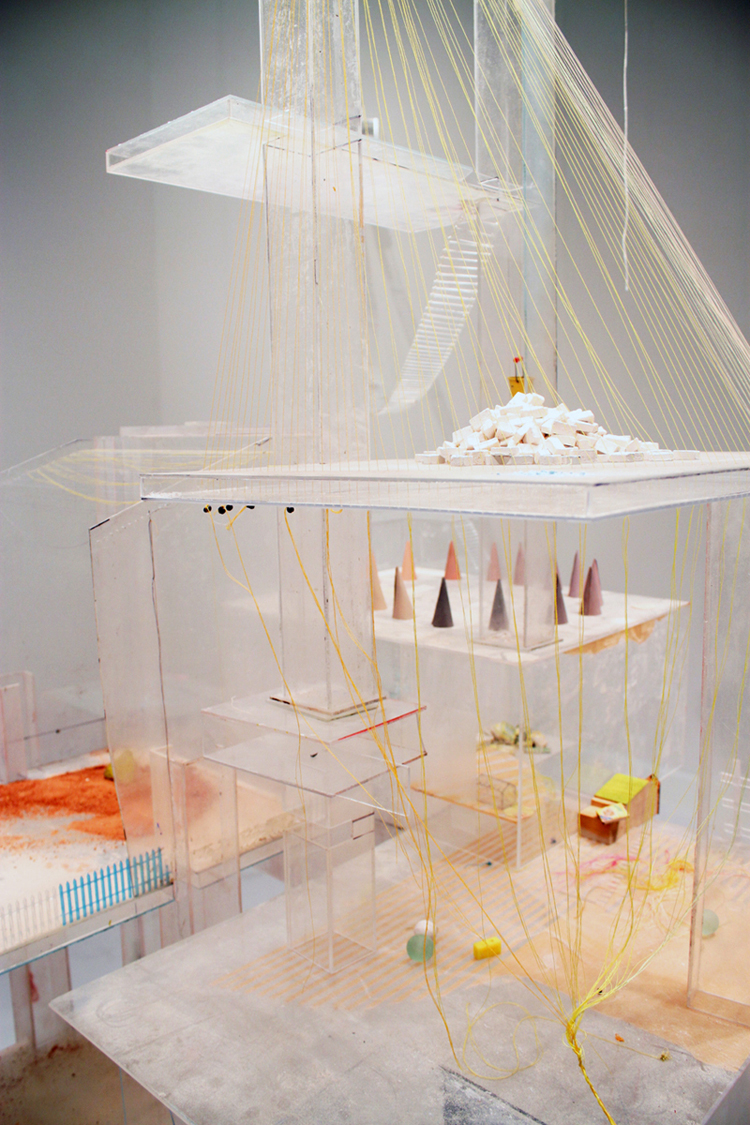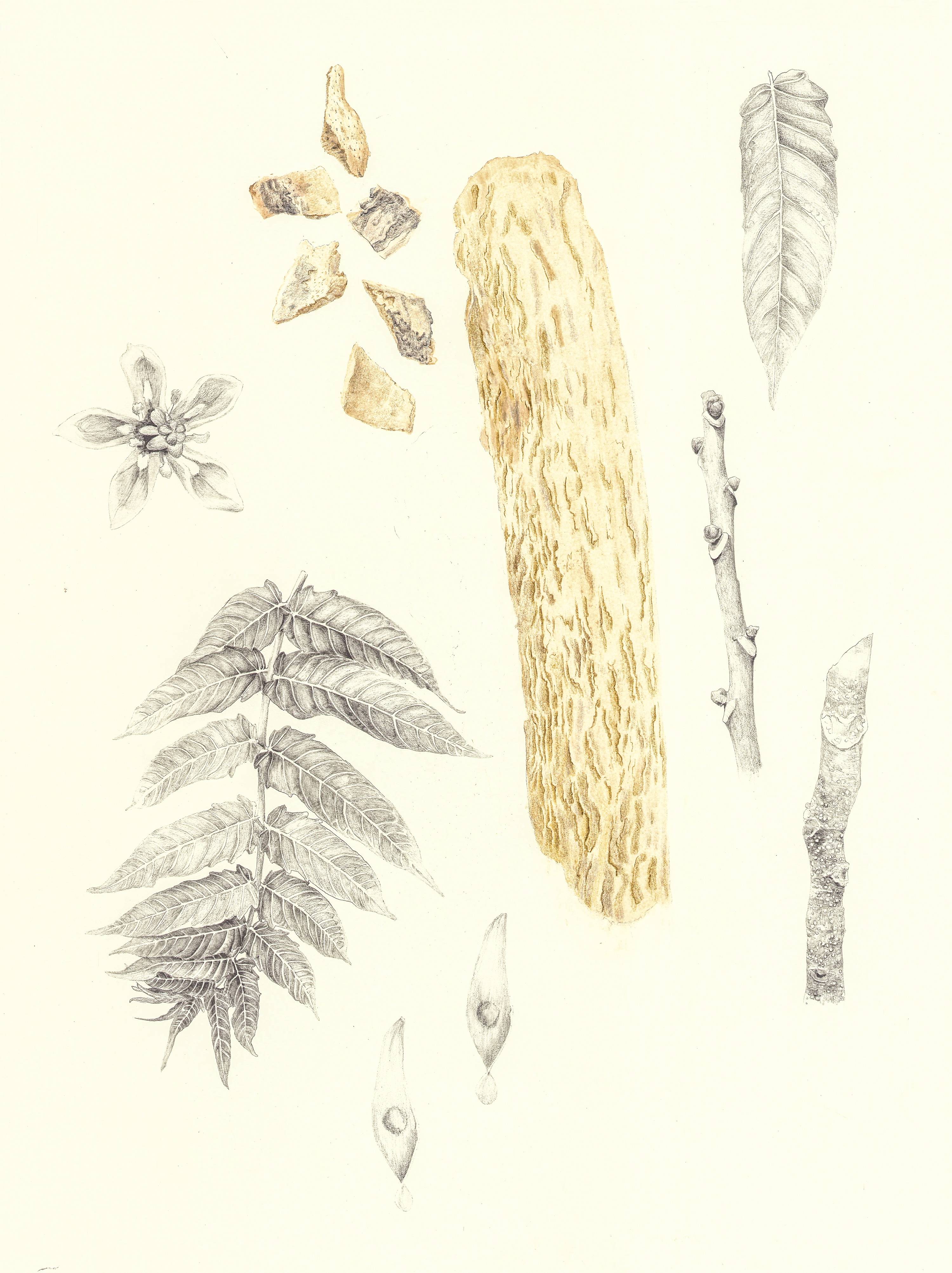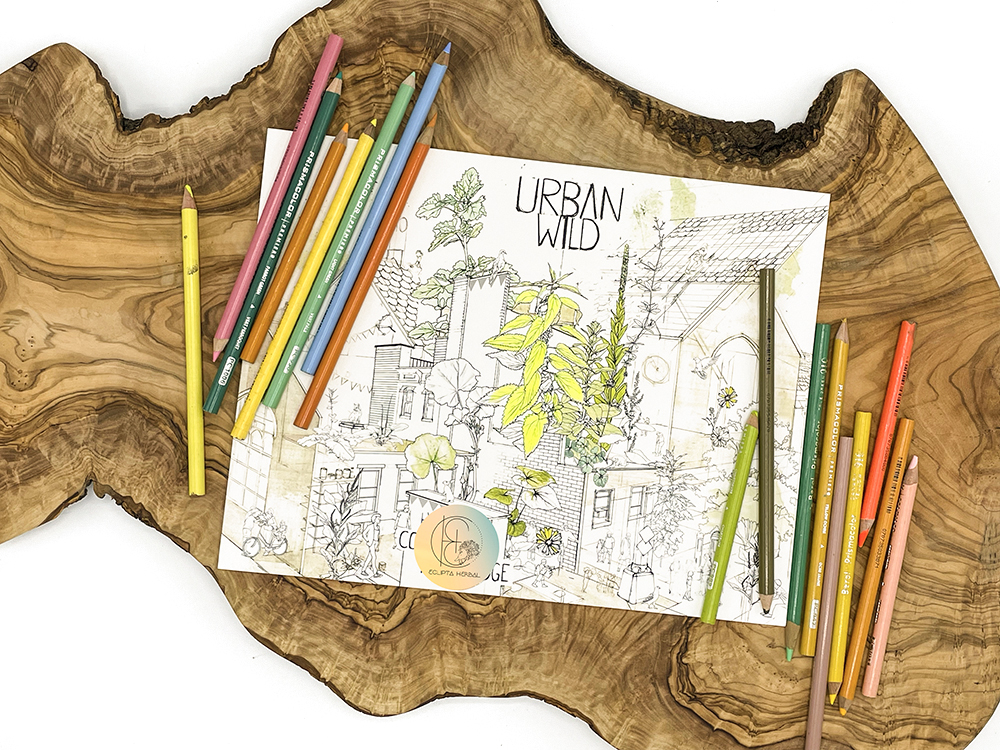Work samples
-
 Soil Savers
Soil SaversSoil Savers, graphite, colored pencil, gouache, pastel on gray toned paper mounted to board 36’’x48’’ 2015
Saving soil in the wake of industrialization & environmental destruction is a must. SOIL = GOLD 🍓🥦🍇 = WEALTH = ABUNDANCE = PEACE ✌️
Biodegradable compost is the single largest component of our everyday trash. Approximately 133 billion pounds or $161 billion pounds worth of food a year. We only have 60yrs (at best) of farmable soil in the US. There is a great need to make composting a priority and put an end to chemical/industrialized farming so that we can restore nutrient density to the very sustenance we depend on. Climate change, toxic farming practices & mono-cropping are equally intertwined with social/racial injustice that literally effect every single one of us.
From Walt Whitman’s poem Compost “.....that when I recline on the grass I do not catch any disease, Though probably every spear of grass rises out of what was once a catching disease. Now I am terrified at the Earth, it is that calm and patient, It grows such sweet things out of such corruptions....”
Like a seed, one or two marks on paper slowly germinate out in all directions, an unfolding process, leaving the demarcations between inside and outside space ambiguous. My drawings are produced with a scientific meticulousness, that can at any moment, be intuitively erased, scraped or layered into forms of suspension and modularity. Like schematics of an archeological excavation, these tectonic forms hang in transparent layers of memory of pre- and post-industrial time. Amid the dusty, pastel hues of dawn or dusk, these dream-like settings of place and non-place wax and wane within a process state between construction, creation or assembly, and decomposition, demolition or decay. Much like a set of child’s building blocks, they are always vulnerable to rearrangement. The presence of the occasional plant or animal serves as a reminder that human made structures have displaced these species yet their ghosts graze on another “plane” just beneath our feet. In addition, the placement of certain mundane elements takes on a mythic presence alluding to a time when dwellings were tools for connecting to and understanding elemental and celestial phenomenon. Images of modern material culture, such as used tires or reclaimed Plexiglas, point to the failures of capitalism, modern ideas of “progress” and dead-end systems of waste. Billboards fashioned as chalkboards advertise a new form of learning as these living systems restructure themselves toward a new beginning.
-
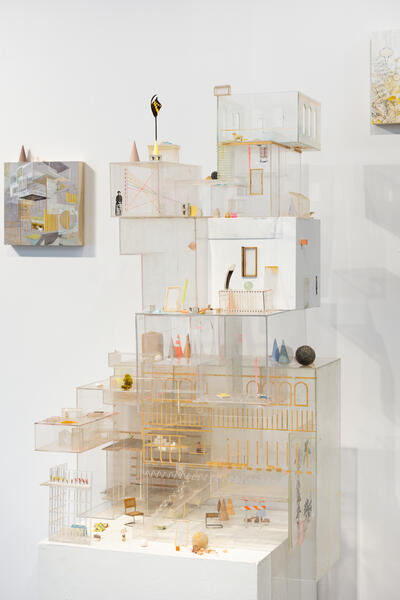 De-Architecture: Adventure Play
De-Architecture: Adventure PlayDe-Architecture: Adventure Play, is an ongoing installation of a network of modular structures made from 100% reclaimed clear Plexiglas and other found objects. This piece asks the question: Are we able to see beyond the narrowing aspects of the dissociative patterns of the dominant human reflection that is the urban infrastructure into a “clearer” vision of mutualism and symbiosis with non-human beings in which we share this land? Simultaneously, the use of recycled plastic echoes failed systems of modernism and the “throw away” culture in which we live. This work is prepared in sections and can be broken down and rearranged many times over much like a set of child’s building blocks; a defiance of permanence and an embrace of shifting paradigms. These components can be clustered together or spread apart as a way to reconfigure or activate any type of indoor or outdoor installation space. The surfaces of the acrylic retain scratches and other debris that work to reflect color and light as much as layers of time. Other materials include handmade miniature clay bricks, miniature trash & miniature houses along with saw dust, clay dust, multicolored thread, paper cones, and other found objects. Some areas are filled with several different colored pigments which resemble geologic cross sections which can be visible, for example, when sections of mountains are cut for road access or during archaeological digs.
Influenced by the post-war Adventure Playgrounds which were built by groups of children 15yrs or younger. In the wake of World War II there remained defunct & abandoned military debris which soon became the curiosity of neighboring youth. The appropriation of these sites by children was seen as a remedy of reform for both the devastation of the land and in providing a younger generation with the opportunity for creative play that would offer a drawing board for a restructuring of society. “Construction” at these sites was never aided or “schooled” by an adult. In the book An Architecture of Play Nils Norman calls the Adventure Playgrounds “radical models of alternative public space” and are examples of [a] “Non-Plan.” Similarly, De-Architecture was built in a series of intuitive iterations rather than with any kind of blueprint which also subverts the singular power of an academically trained architect who builds our fixed visual environments.
Available for Purchaseplease email [email protected]
-
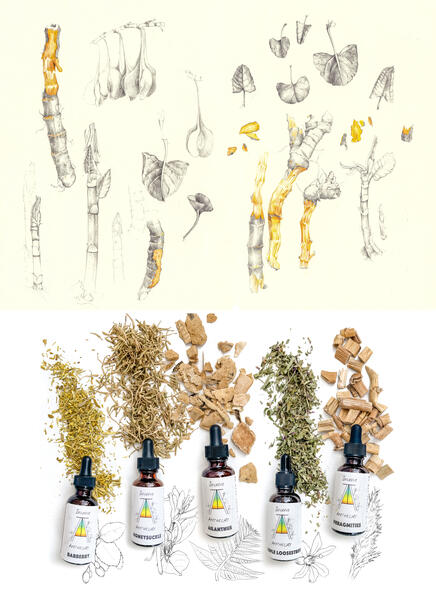 Urban Invasive Medicinals
Urban Invasive MedicinalsUrban Invasive Medicinals is a series of hand-rendered drawings depicting the top five most pervasive/invasive plants in the Northeastern U.S. and more specifically in New York City where I was living at the time. What can we learn from the intelligent thriving of these particular plants within the urban industrial landscape? I’m interested in the dualistic cultural perspectives & ideas of antidote vs poison, the concept of “quackery" vs indigenous wisdom, intuitivism vs. science and the dangers of corporate greed upon our health & the health of this planet. One of the largest culprits of the proliferation of invasives is the lack of intimate human involvement with these species & the land in which they "prosper". This series is part of a much larger project called the Invasive Apothecary and the Invasive Species Creative Proposal Series. These three efforts reflect my medical herbalism studies into Chinese Medicine while deconstructing popular notions of invasive species by rejecting the over-simplified colonially imposed binaries of intolerant militaristic, war-like language used to describe invasive species but also by examining their larger ecological potentials, the contemporary & historical human relationships to the land & the use of invasive species as food and medicine by non -"Western" cultures. These endeavors look at how the erasure of traditional-ecological-knowledge (TEK) from indigenous peoples (from around the world), about these plants, has been abandoned at the expense of dissociating us from the fact that their curative human virtues directly mirror the remedial virtues for the land. This work is about reconnecting to sacred subsistence economies which sit at the intersection of resource sustainably & ecological literacy. It is part of decolonizing what we consider medicine & our relationship with the land while healing the eco-grief, business-as-usual paradigm which falsely touts that corporate toxic chemical herbicide is the only solution to ecosystem biodiversity. Ecologist Brendon Larson states that the inaccurate perceptions of invasive species, "contribute to social misunderstanding, charges of xenophobia, & loss of scientific credibility.” Many of these species are known as cooling remedies to the over active heat (fever/inflammation) of the human body. Could it be that they are doing the same for the excess urban heat sink as much as combating the toxic heat of our manufactured landscapes?
When will we realize that to heal the land we must heal ourselves and vice versa? The human body and the earth body are one in the same. Working with these plants as medicine as well as learning from the ancient indigenous practices puts us in direct symbiotic relationship with the sentient healing capacity of plants as aids in guiding us out of climate devastation.
Each drawing, for the Urban Invasive Medicinal series, was done in the style of a classical botanical drawing of the 18th century & is meant to be a subversive act which comments on the idea that only "prized", "useful", "beautiful" plants, to the white colonial mind-set, are worthy of being depicted in scientific illustration. Color for each work was intentionally reserved for the part(s) of these common "weedy" plants which have a long cultural history of medicinal use in China, India & the Americas yet have often been omitted in various European/American botanical portfolios throughout the centuries.
-
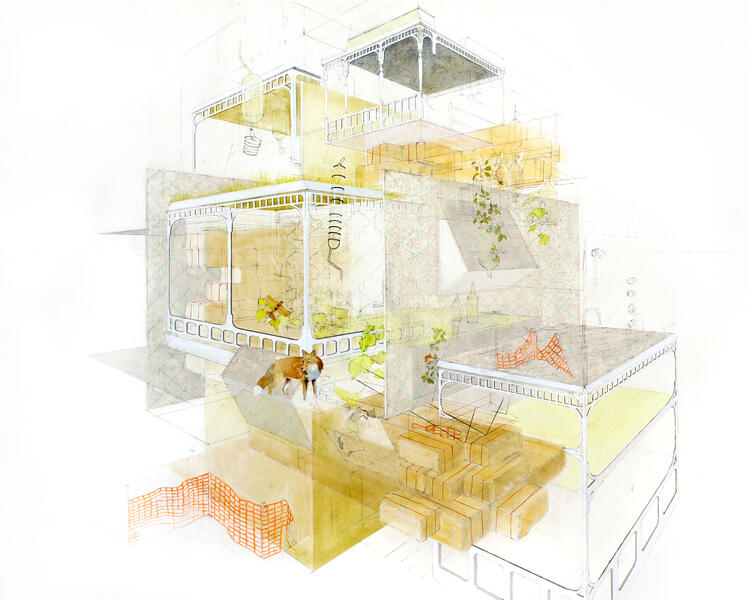 True Fox
True FoxTrue Fox is part of an ongoing series of works on paper inspired by my work in straw bale building.
In 2002 I visited Mali, West Africa & learned about the beauty, genius & efficiency of adobe building; the protective cool clay earthen structures in contrast to the heat of the dry desert sun. This inspired my academic research into a host of natural building techniques which then lead me to doing hands-on training in passive solar technology, straw bale building, adobe plaster & green roof construction. In 2007 I worked as a laborer for 11months for Furbish, Co, Baltimore, MD to build a 27,000 sqft straw bale Friends Community School in College Park, MD. Straw bale building is a technique using bales of straw which are produced as a byproduct of an industrial wheat harvest. Straw is not the same as hay & is mostly inedible so when it isn’t being used for animal bedding it becomes a waste product & is burned. Building with this industrial byproduct diverts a massive carbon footprint (by not burning) while diverting the use of highly polluting/extractive conventional construction methods & materials. In addition, exterior walls constructed of straw bales maintain an R-value of about 25 (that's huge!) which significantly increases the energy savings throughout the life of the building. Building with plants has inspired a profound search for a connection to nature within the city landscapes where I’ve spent most of my life.
The building industry is the most grandiose forms of material culture but also one of the most environmentally destructive & unsustainable. Approximately 40% of solid waste generated worldwide comes from construction and demolition activities. In the United States alone, the construction industry generates more than 600 million tons of waste annually. When I began doing work about architecture in 2006 the ideas of what would or could be defined as architecture was & sometimes still are reserved for those who study within an industrial or “Western” pedagogy & certainly did not include the ingenuity of vernacular architecture built by “non-architect’s” or from 1,000’s or more years of reciprocal engagements (or stewardship) with the raw or non-industrialized materials of an inhabitant’s immediate surroundings. Architecture built of thatch, goat skin, sod or adobe to name a few.
About Alyssa
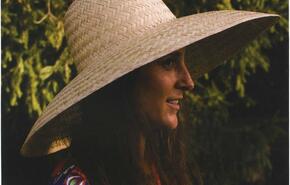
My work combines drawing, sculptural installation and the social/environmental practice of herbalism to investigate themes of ecosystem sustainability within the manufactured landscapes of the built environment. My focus is to question modern architecture and the modern mind-set by depicting a hybridization of overlapping structures that consider intersecting and deviating lines between protection, dominion and symbiosis. What are the ways in which conventional forms of… more
Strawbale
This is an ongoing series of works on paper influenced by my work in straw bale building.
In 2002 I visited Mali, West Africa & learned about the beauty, genius & efficiency of adobe building; the protective cool clay earthen structures in contrast to the heat of the dry desert sun. This inspired an academic research into a host of natural building techniques which then lead me to doing hands-on training in passive solar technology, straw bale building, adobe plaster & green roof construction. In 2007 I worked as a laborer for 11months for Furbish, Co, Baltimore, MD to build a 27,000 sqft straw bale Friends Community School in College Park, MD. Straw bale building is a technique using bales of straw which are produced as a byproduct of an industrial wheat harvest. Straw is not the same as hay & is mostly inedible so when it isn’t being used for animal bedding it becomes a waste product & is burned. Building with this industrial byproduct diverts a massive carbon footprint (by not burning) while diverting the use of highly polluting/extractive conventional construction methods & materials. In addition, exterior walls constructed of straw bales maintain an R-value of about 25 (that's huge!) which significantly increases the energy savings throughout the life of the building. Building with plants has inspired a profound search for a connection to nature within the city landscapes where I’ve spent most of my life.
The building industry is the most grandiose forms of material culture but also one of the most environmentally destructive & unsustainable. Approximately 40% of solid waste generated worldwide comes from construction and demolition activities. In the United States alone, the construction industry generates more than 600 million tons of waste annually. When I began doing work about architecture in 2006 the ideas of what would or could be defined as architecture was & sometimes still are reserved for those who study within an industrial or “Western” pedagogy & certainly did not include the ingenuity of vernacular architecture built by “non-architect’s” or from 1,000’s or more years of reciprocal engagements (or stewardship) with the raw or non-industrialized materials of an inhabitant’s immediate surroundings. Architecture built of thatch, goat skin, sod or adobe to name a few.
-
 Greenhouse Fox
Greenhouse Fox -
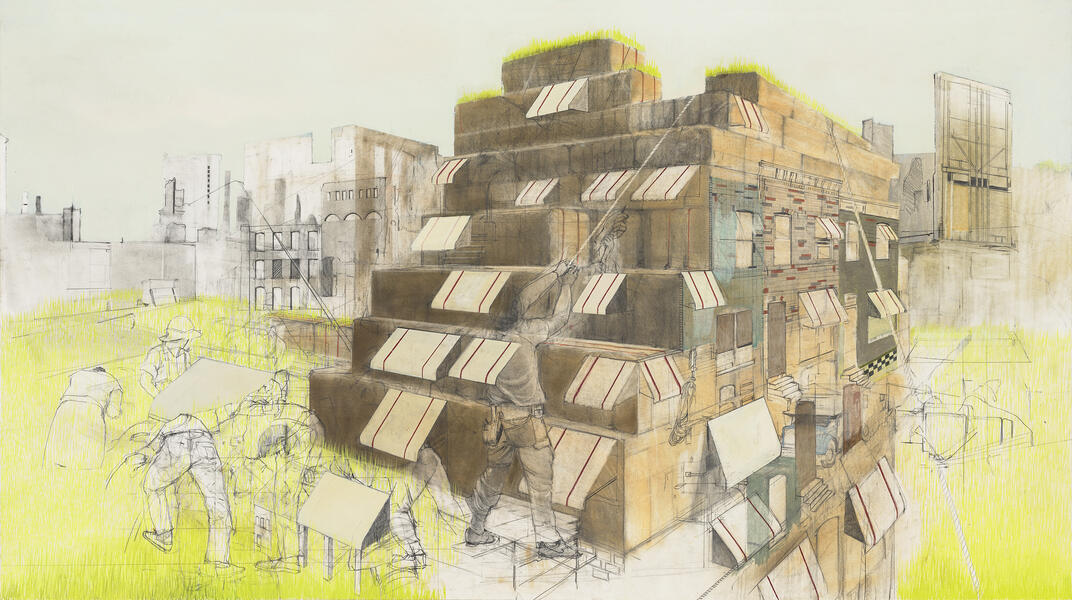 Module Stack
Module Stack -
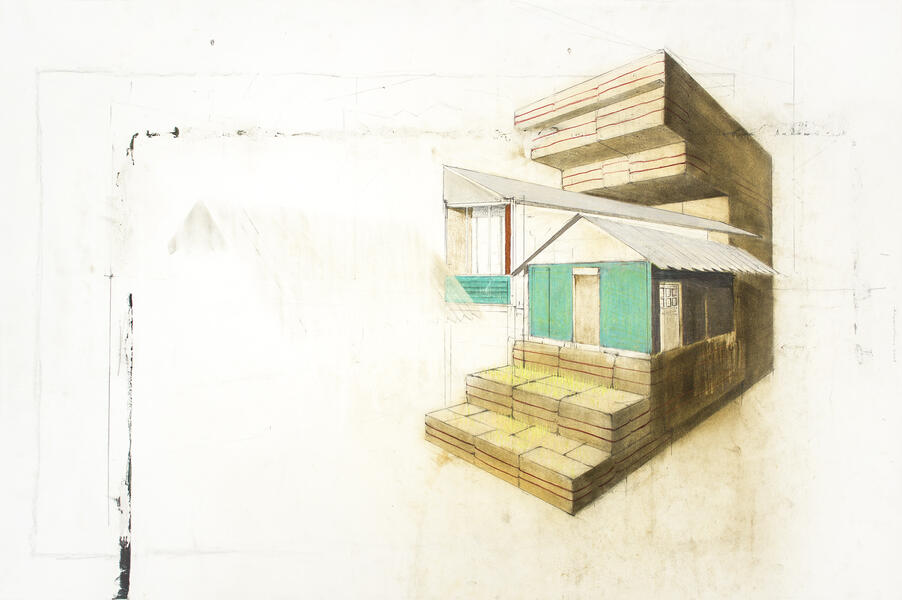 Strawbale House
Strawbale House -
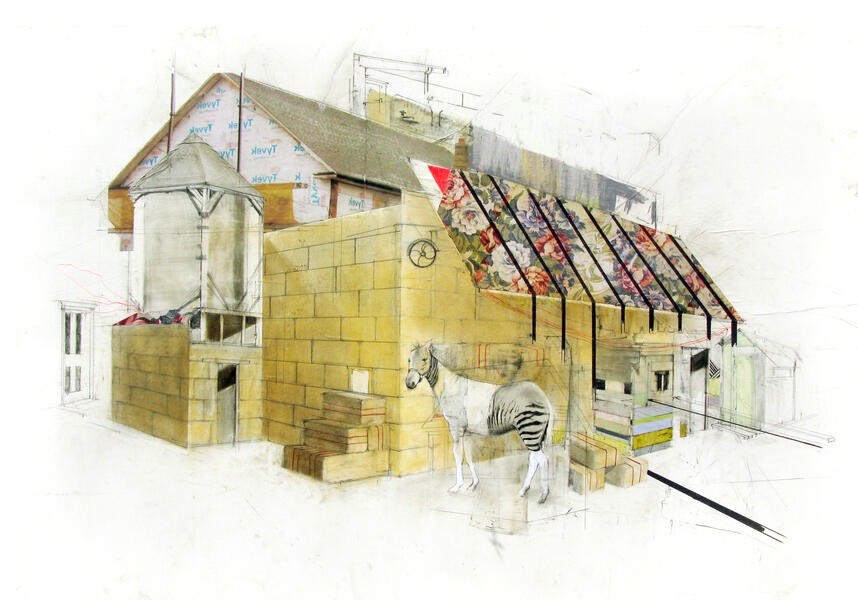 Striped
Striped -
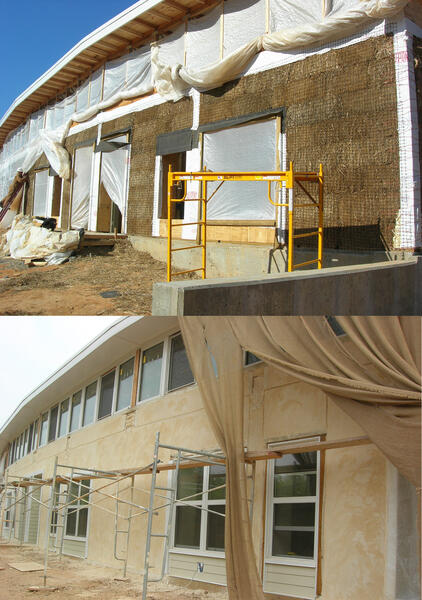 Strawbale Building
Strawbale BuildingThese are pictures I took while working for Furbish Company to build a 27,000 sq ft Friends Community School, Collage Park, MD. They show the exterior strawbale walls with the adobe plaster finish. I worked on this project from the ground up learning alls the various ins & outs of building with the byproduct of a wheat harvest (from a local Maryland farm) and earthen clay harvested right from the site.
De-Architecture: Adventure Play
De-Architecture: Adventure Play, is an ongoing installation of a network of modular structures made from 100% reclaimed clear Plexiglas and other found objects. This piece asks the question: Are we able to see beyond the narrowing aspects of the dissociative patterns of the dominant human reflection that is the urban infrastructure into a “clearer” vision of mutualism and symbiosis with non-human beings in which we share this land? Simultaneously, the use of recycled plastic echoes failed systems of modernism and the “throw away” culture in which we live. This work is prepared in sections and can be broken down and rearranged many times over much like a set of child’s building blocks; a defiance of permanence and an embrace of shifting paradigms. These components can be clustered together or spread apart as a way to reconfigure or activate any type of indoor or outdoor installation space. The surfaces of the acrylic retain scratches and other debris that work to reflect color and light as much as layers of time. Other materials include handmade miniature clay bricks, miniature trash & miniature houses along with saw dust, clay dust, multicolored thread, paper cones, and other found objects. Some areas are filled with several different colored pigments which refer to geologic cross sections which can be visible, for example, when sections of mountains are cut for road access or during archaeological digs.
Influenced by the post-war Adventure Playgrounds which were built by groups of children 15yrs or younger. In the wake of World War II there remained defunct & abandoned military debris which soon became the curiosity of neighboring youth. The appropriation of these sites by children was seen as a remedy of reform for both the devastation of the land and in providing a younger generation with the opportunity for creative play that would offer a drawing board for a restructuring of society. “Construction” at these sites was never aided or “schooled” by an adult. In the book An Architecture of Play Nils Norman calls the Adventure Playgrounds “radical models of alternative public space” and are examples of [a] “Non-Plan.” Similarly, De-Architecture was built in a series of intuitive iterations rather than with any kind of blueprint which also subverts the singular power of an academically trained architect who builds our fixed visual environments.
-
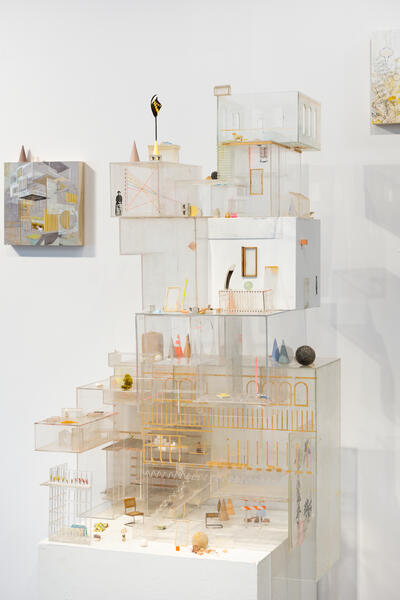 De-Architecture: Adventure Play
De-Architecture: Adventure PlayThis is one of many different iterations of this project for BmoreArt's Collect & Connect Gallery.
-
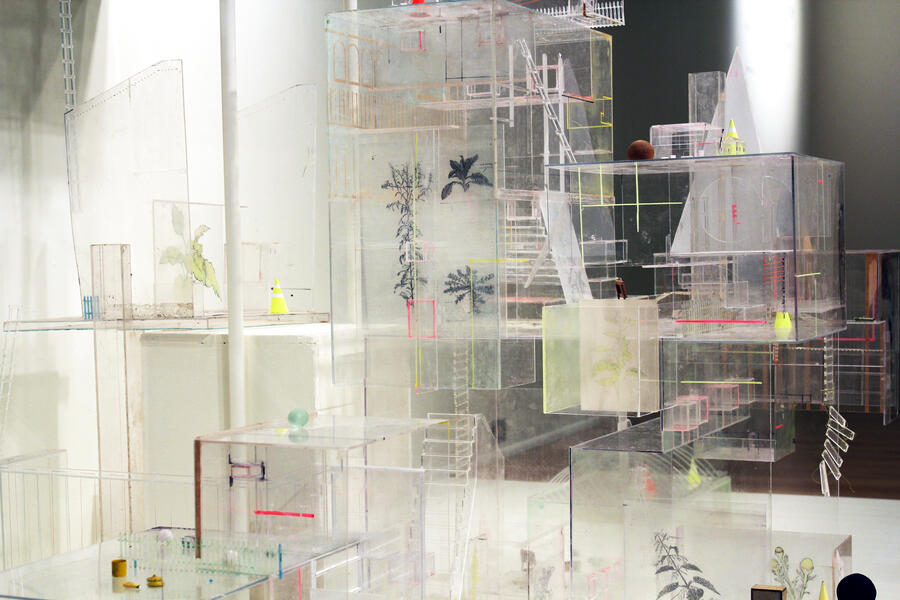 De-Architecture: Adventure Play (detail)
De-Architecture: Adventure Play (detail)A detail of De-Architecture: Adventure Play
-
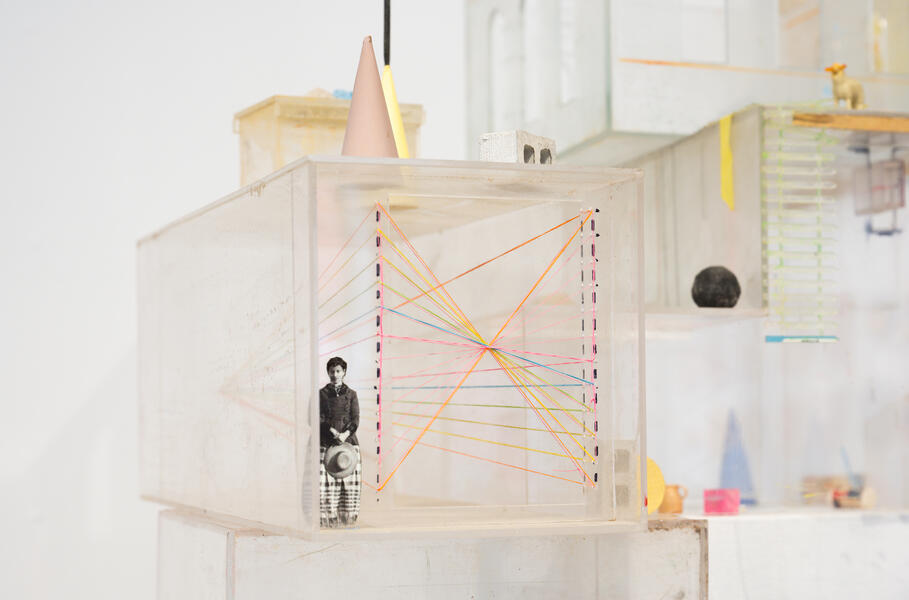 De-Architecture: Adventure Play (detail)
De-Architecture: Adventure Play (detail)A detail of De-Architecture
-
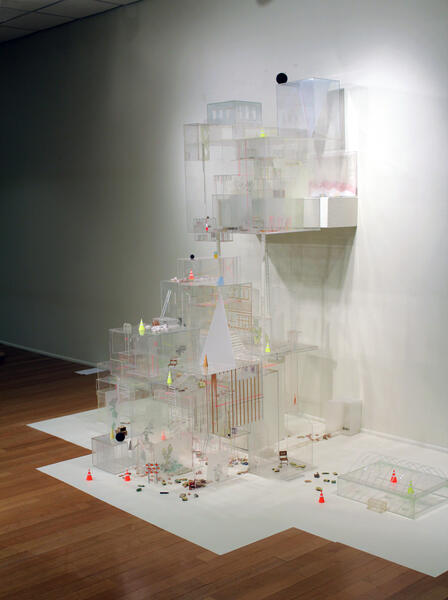 De-Architecture: Adventure Play (detail)
De-Architecture: Adventure Play (detail)De-Architecture: Adventure Play for an installation at University of Maryland, College Park, MD
-
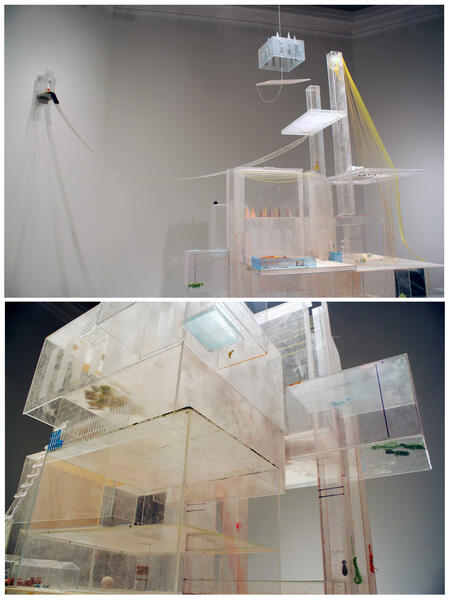 De-Architecture: Adventure Play (detail)
De-Architecture: Adventure Play (detail)De-Architecture: Adventure Play for an installation at Tulane University, New Orleans.
-
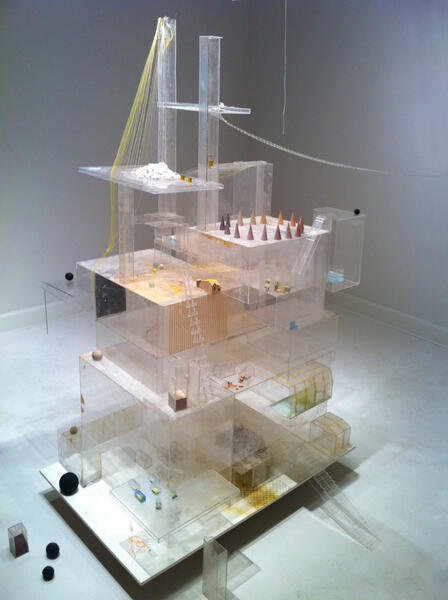 De-Architecture: Adventure Play (detail)
De-Architecture: Adventure Play (detail)De-Architecture: Adventure Play installation at Tulane University
-
 De-Architecture: Adventure Play (detail)
De-Architecture: Adventure Play (detail)A detail of De-architecture: Adventure Play
-
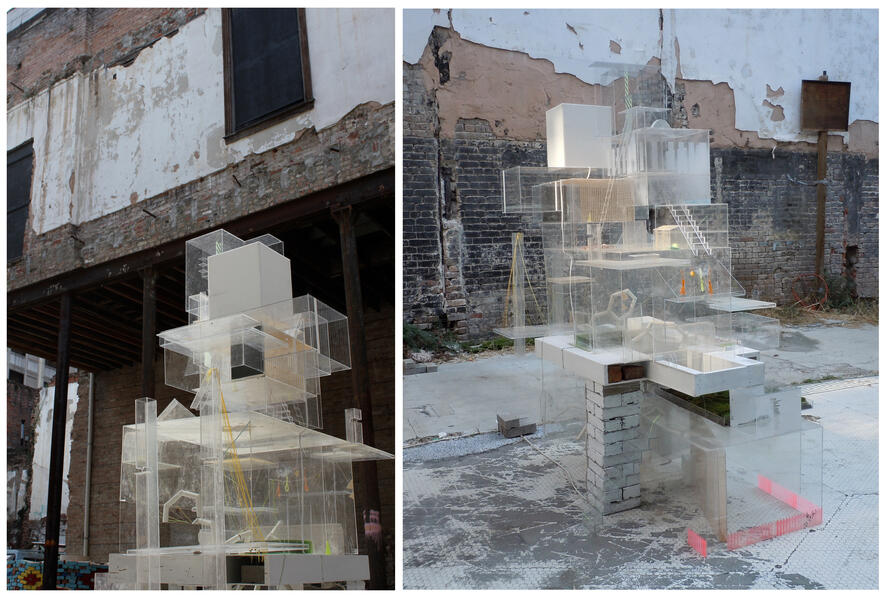 De-Architecture: Adventure Play (detail)
De-Architecture: Adventure Play (detail)De-Architecture: Adventure Play in an outdoor installation for Parse Gallery, New Olreans
-
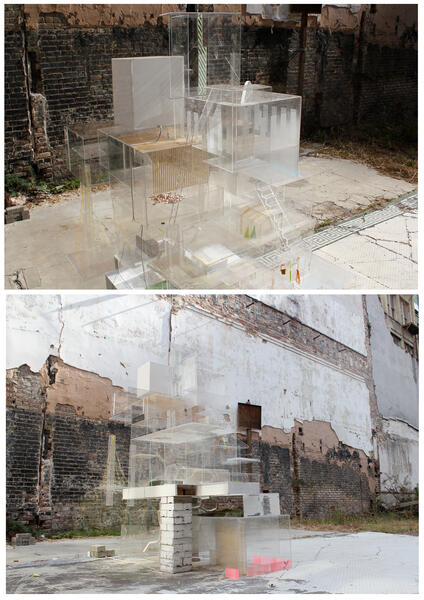 De-Architecture: Adventure Play
De-Architecture: Adventure PlayDe-Architecture: Adventure Play for an outdoor installation at Parse Gallery, New Orleans, LA
-
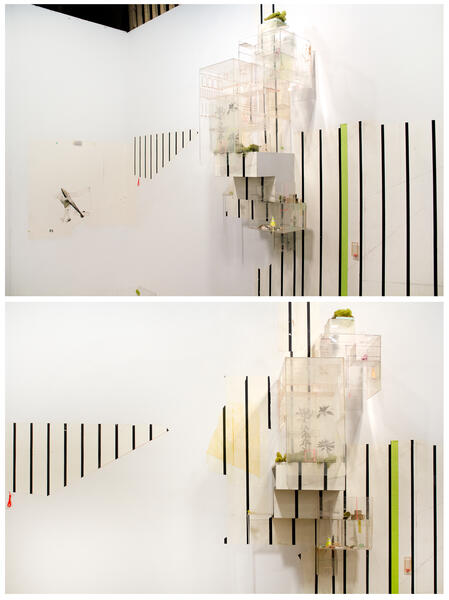 De-Architecture: Adventure Play (detail)
De-Architecture: Adventure Play (detail)A detail of De-Architecture installation at the Re-Institute, NY
Works on Paper 1
Like a seed, one or two marks on paper slowly germinate out in all directions, an unfolding process, leaving the demarcations between inside and outside space ambiguous. My drawings are produced with a scientific meticulousness, that can at any moment, be intuitively erased, scraped or layered into forms of suspension and modularity. Like schematics of an archeological excavation, these tectonic forms hang in transparent layers of memory of pre- and post-industrial time. Amid the dusty, pastel hues of dawn or dusk, these dream-like settings of place and non-place wax and wane within a process state between construction, creation or assembly, and decomposition, demolition or decay. Much like a set of child’s building blocks, they are always vulnerable to rearrangement. The presence of the occasional plant or animal serves as a reminder that human made structures have displaced these species yet their ghosts graze on another “plane” just beneath our feet. In addition, the placement of certain mundane elements takes on a mythic presence alluding to a time when dwellings were tools for connecting to and understanding elemental and celestial phenomenon. Images of modern material culture, such as used tires or reclaimed Plexiglas, point to the failures of capitalism, modern ideas of “progress” and dead-end systems of waste. Billboards fashioned as chalkboards advertise a new form of learning as these living systems restructure themselves toward a new beginning.
This section spans seventeen years of large works on paper. View more here.
-
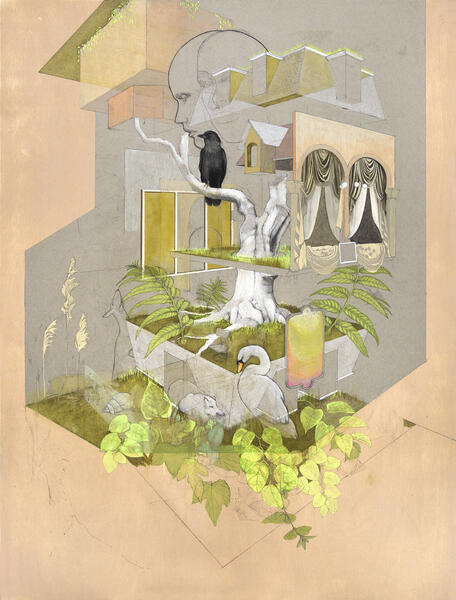 Urban Artemis
Urban ArtemisUrban Artemis, graphite, gouache, pastel, colored pencil on toned paper mounted to board, 48’’x36’’, 2023
This piece is about the loss of the old growth forest ecosystem as another symptomatic cause of the pervasiveness of invasive plants such as Ailanthus, Knotweed and Mulberry which are also depicted.
-
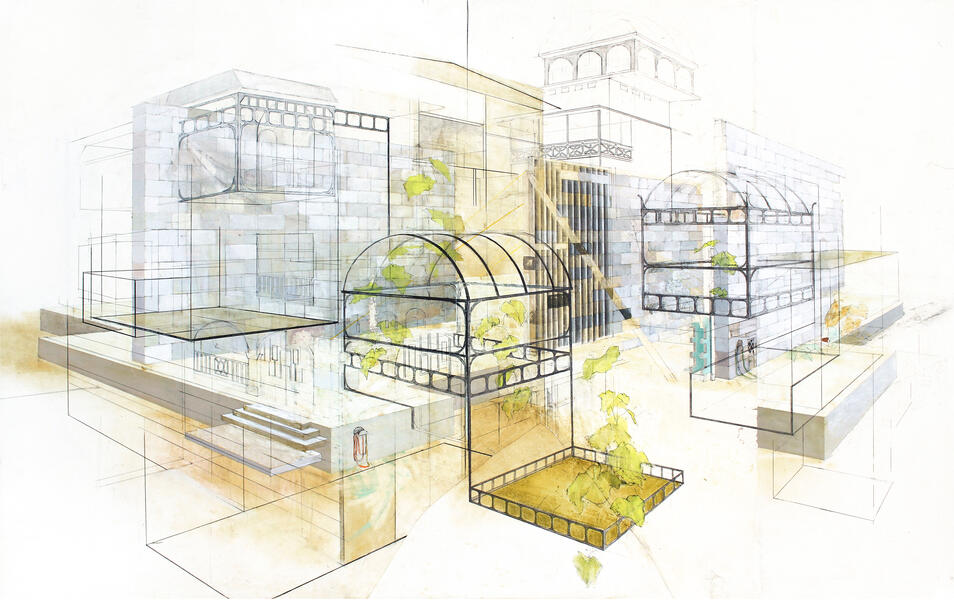 Greenhouse
GreenhouseGreenhouse, graphite, pastel, gouache, dry pigment on paper mounted to board, 36’’x 58’’, 2014
-
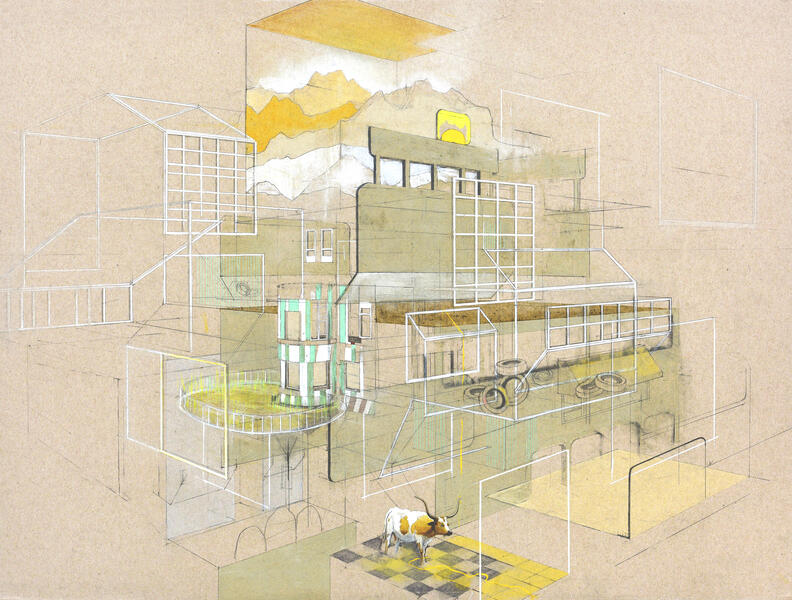 Sunset Cycle
Sunset CycleSunset Cycle, graphite, pastel, colored pencil, gouache on paper, 24’’x32’’, 2015
-
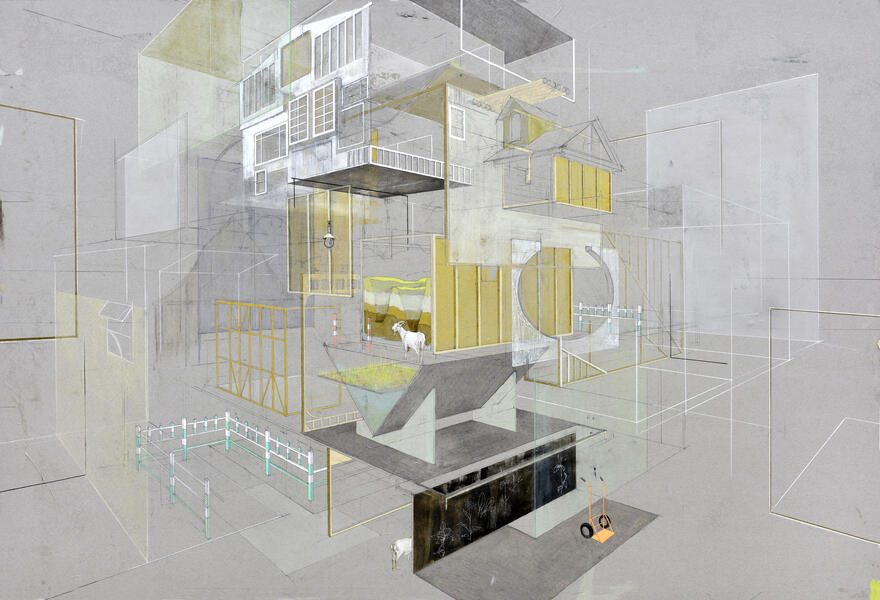 Cycle Resource
Cycle ResourceCycle Resource, graphite, pastel, colored pencil, gouache on paper, 42’’x66’’, 2015
-
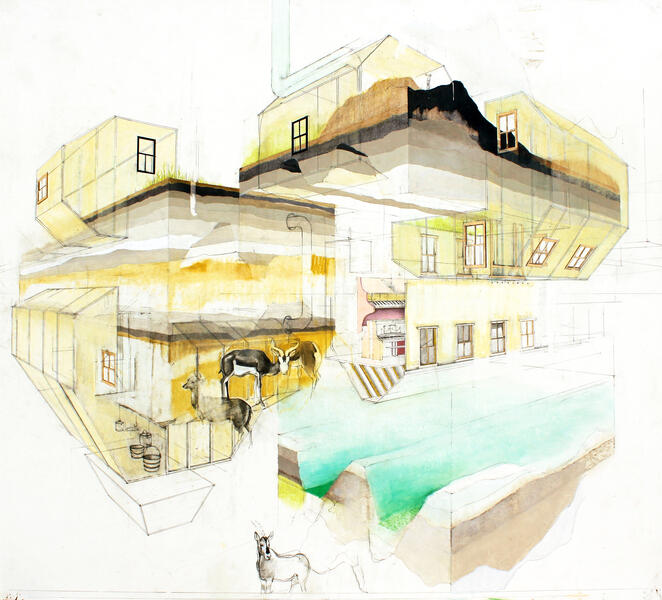 Levels
LevelsLevels, graphite, pastel, gouache, colored pencil on paper mounted to board, 42’’x48’’, 2012
-
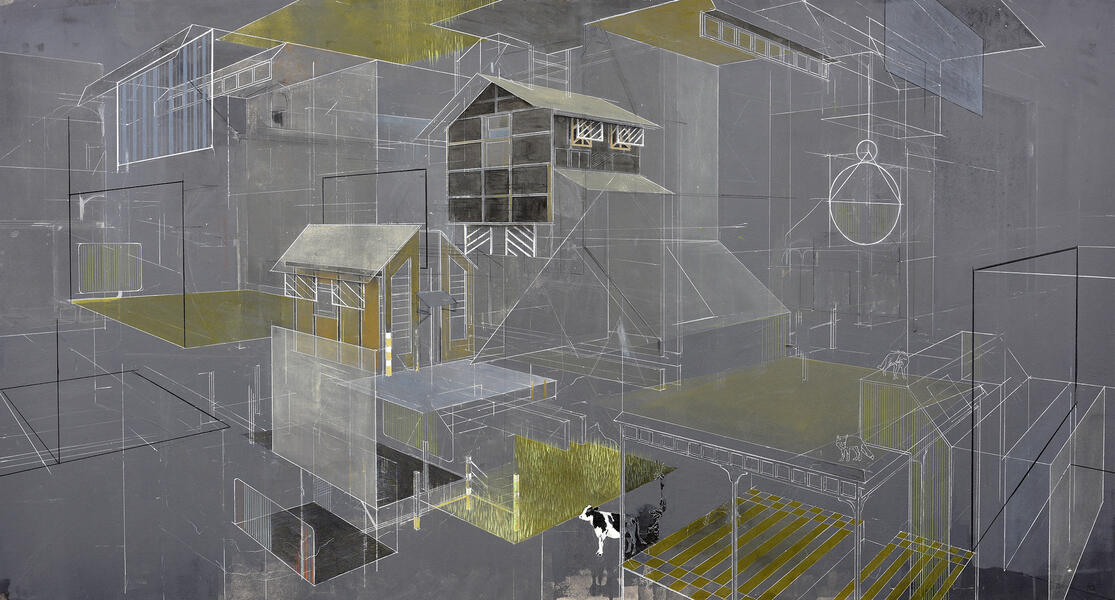 Ley-lines in Chalk
Ley-lines in ChalkLey- Lines in Chalk, graphite, pastel, gouache, dry pigment on painted paper mounted to board, 42’’x 78’’, 2014
-
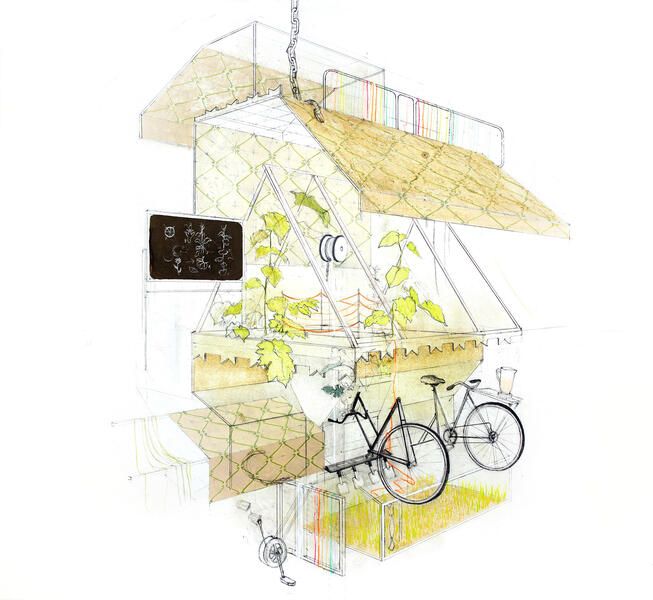 Farm Camp
Farm CampFarm Camp, graphite, gouache, colored pencil, pastel, 20’’x22’’, 2015
-
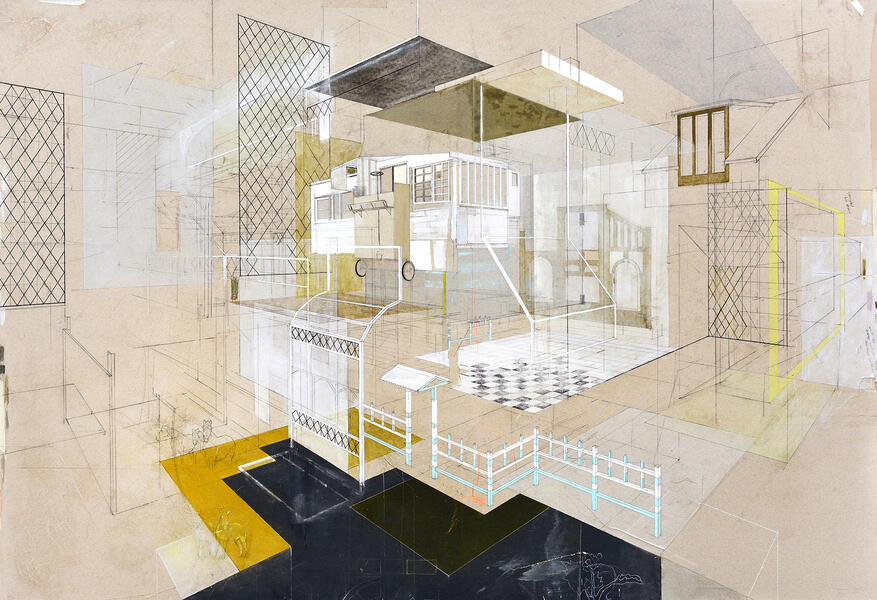 Shack
ShackShack, graphite, pastel, gouache, colored pencil, dry pigment on toned paper mounted to board, 42.5’’x 62’’, 2015
-
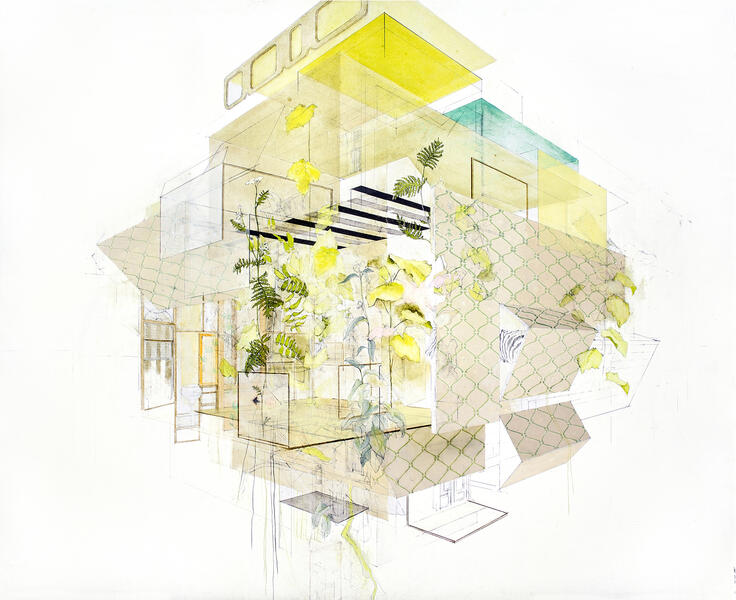 Resource Viability
Resource ViabilityResource Viability, graphite, colored pencil, gouache on paper mounted to board, 48’’x50’’, 2015
-
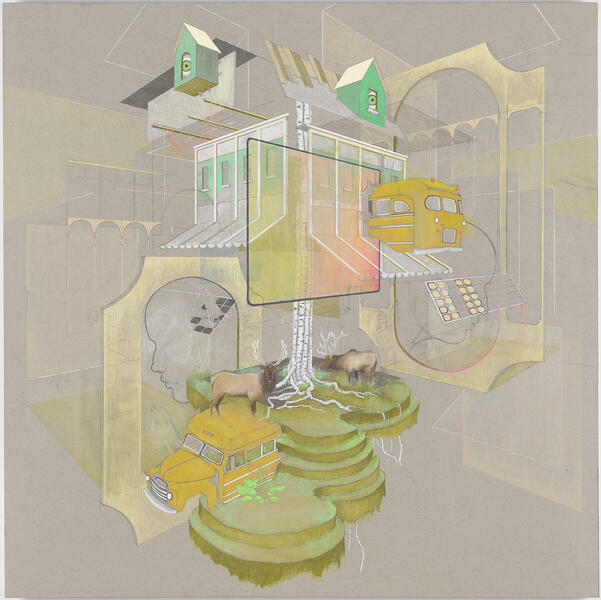 Birch & Elk
Birch & ElkBirch & Elk, graphite, pastel, gouache, colored pencil on gray paper mounted to board, 42’’x 42’’, 2021
Urban Invasive Medicinals
Urban Invasive Medicinals is a series of hand-rendered drawings depicting the top five most pervasive/invasive plants in the Northeastern U.S. and more specifically in New York City where I was living at the time. What can we learn from the intelligence thriving of these particular plants within the urban industrial landscape? I’m interested in the dualistic cultural perspectives & ideas of antidote vs poison, the concept of “quackery" vs indigenous wisdom, intuitivism vs. science and the dangers of corporate greed upon our health & the health of this planet.
One of the largest culprits of the proliferation of invasives is the lack of intimate human involvement with these species & the land in which they "prosper". This series of drawings are part of a much larger project called the Invasive Apothecary and the Invasive Species Creative Proposal Series. These three efforts reflect my medical herbalism studies into Chinese Medicine while deconstructing popular notions of invasive species by rejecting the over-simplified colonially imposed binaries of intolerant militaristic, war-like language used to describe invasive species but also by examining their larger ecological potentials, the contemporary & historical human relationships to the land & the use of invasive species as food and medicine by non -"Western" cultures. These endeavors look at how the erasure of traditional-ecological-knowledge (TEK) from indigenous peoples (from around the world), about these plants, has been abandoned at the expense of dissociating us from the fact that their curative human virtues directly mirror the remedial virtues for the land. This work is about reconnecting to sacred subsistence economies which sit at the intersection of resource sustainably & ecological literacy. It is part of decolonizing what we consider medicine & our relationship with the land while healing the eco-grief, business-as-usual paradigm which falsely touts that corporate toxic chemical herbicide is the only solution to ecosystem biodiversity. Ecologist Brendon Larson states that the inaccurate perceptions of invasive species, "contribute to social misunderstanding, charges of xenophobia, & loss of scientific credibility.” Many of these species are known as cooling remedies to the over active heat (fever/inflammation) of the human body. Could it be that they are doing the same for the excess urban heat sink as much as combating the toxic heat of our manufactured landscapes?
When will we realize that to heal the land we must heal ourselves and vice versa? The human body and the earth body are one in the same. Working with these plants as medicine as well as learning from the ancient indigenous practices puts us in direct symbiotic relationship with the sentient healing capacity of plants as aids in guiding us out of climate devastation.
Each drawing, for the Urban Invasive Medicinal series, was done in the style of a classical botanical drawing of the 18th century & is meant to be a subversive act which comments on the idea that only "prized", "useful", "beautiful" plants, to the white colonial mind-set, are worthy of being depicted in scientific illustration. Color for each work was intentionally reserved for the part(s) of these common "weedy" plants which have a long cultural history of medicinal use in China, India & the Americas yet have often been omitted in various European/American botanical portfolios throughout the centuries.
-
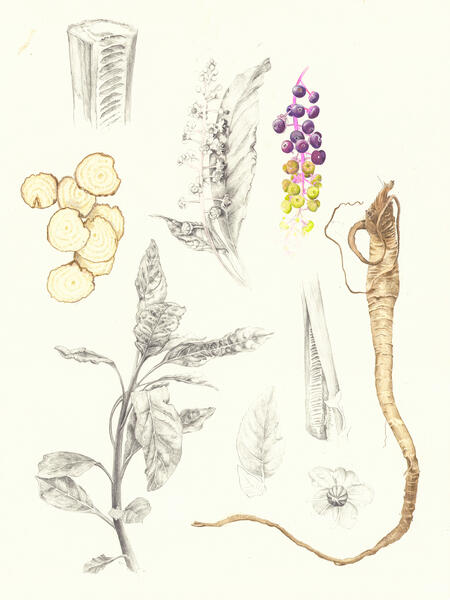 Pokeweed (Phytolacca americana)
Pokeweed (Phytolacca americana)Contrary to popular belief there are indeed native invasives. Poke is one of them. Worked with for centuries in the Americas as a dietary green (only when boiled in water 3 times). The root and berry are also a well known lymphatic medicine used in very small drop doses for extreme cases of lymphatic cancer.
Pokeweed, graphite colored pencil on paper, 18''x24'', 2022
-
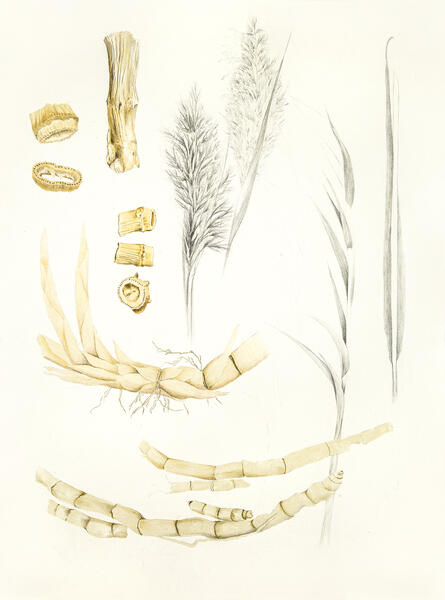 Phragmites (Phragmites australis)
Phragmites (Phragmites australis)Phragmites rhizome has been part of popular cold and flu formulas within the Chinese methodology of medicine for centuries. Clears infectious toxic heat from the body. Phragmites is also scientifically proven to remove toxic chemicals associated with urban industry which have been deposited into near by bodies of water where Phragmites thrives.
Phragmites, graphite colored pencil on paper, 18''x24'', 2022
-
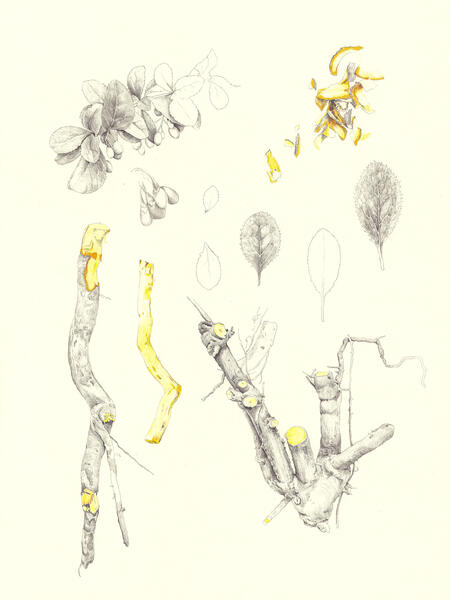 Barberry (Berberis vulgaris)
Barberry (Berberis vulgaris)The neon yellow root of Barberry removes heat and damp stagnation, promotes digestive assimilation and mucosal secretions. For hot dry conditions of diarrhea and dysentery, viral infections, inflammation and malignant fevers.
Eastern tribes such as the Mi’kmaq used the bark and root for sore throat and ulcerated gums. The Mohegan drank a cooled decoction of berries for fever. The Shinnecock decocted leaves and drank the tea for jaundice. The Cherokee called it “yellow eyes”, or DI Ga Do Li, Da Lo Ni Ge I. It was used as part of a formula for racing hearts according to Garrett. (Robert Dale Rogers)
Barberry, graphite colored pencil on paper, 18''x24'', 2022
-
 Ailanthus (Ailanthus altissima)
Ailanthus (Ailanthus altissima)Ailanthus bark has also been used as part of cold and flu formulas within Chinese medicine. Clears heat, drys dampness while astringing the intestinal tissue to treat parasites. Ailanthus can also offer remedial benefits for toxic urban environments where they thrive. The leaves absorb significant amounts of sulfur in areas of high traffic flow, can accumulate high levels of mercury in their tissues and can survive just fine near cement and lime works factories. Aka The Tree of Heaven. A species that can grow when nothing else can. Thank you!
Ailanthus, graphite colored pencil on paper, 18''x24'', 2022
-
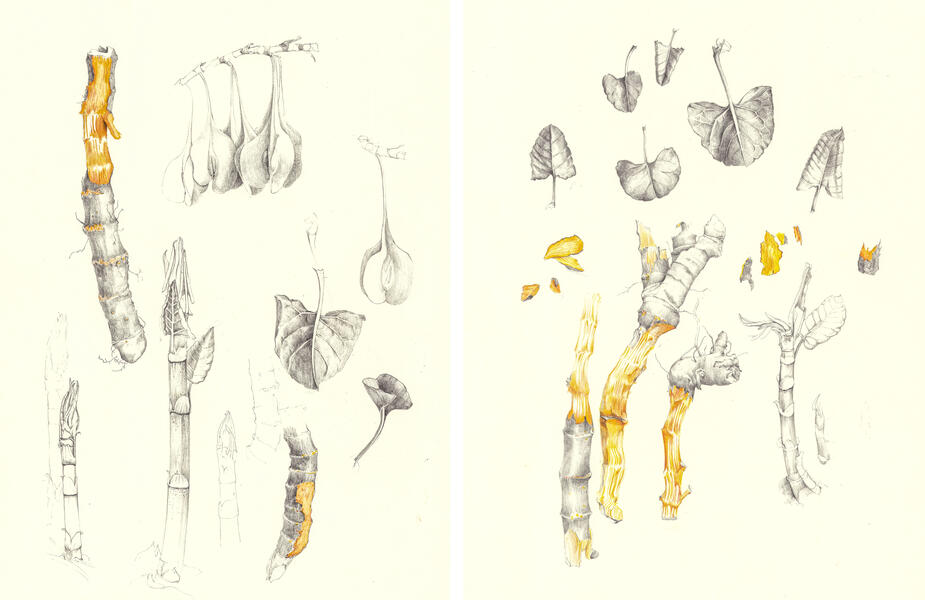 Knotweed
KnotweedConsidered leading the race as most invasive plant in the many industrialized parts of the world. Young fresh shoots can be eaten in spring. Traditional East Asian medicine considers Knotweed blood-invigorating & stasis removing (Chen & Chen). Helping clear the waters of the body of infection. Also widely used in the treatment of Lyme disease. The largest supplier of the antioxidant supplement resveratrol is from Knotweed root. Resveratrol is also found in grape skins and it among other antioxidant rich foods are key in preventing heart disease...the number one killer in the U.S. Knotweed is also scientifically proven to bioremediate lead from the soil.
Japanese Knotweed, graphite colored pencil on paper, 36''x24'', 2022
-
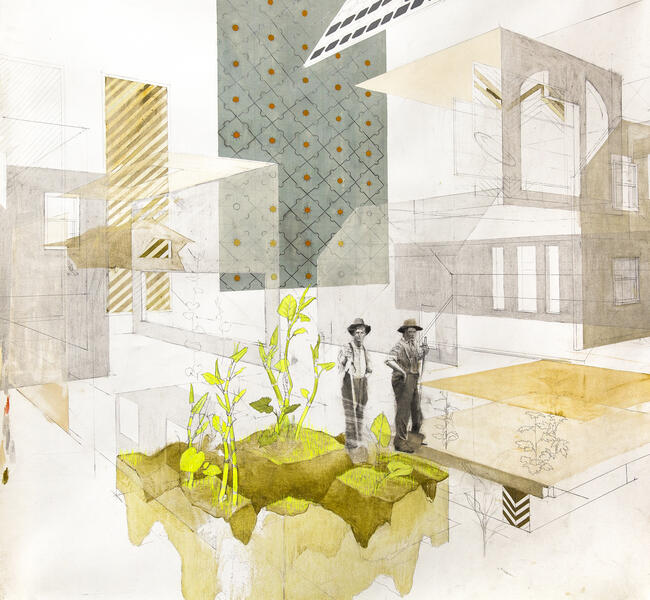 Knotweed Farmer
Knotweed FarmerKnotweed Farmer, graphite, colored pencil, gouache, pastel on paper, 42''x48'', 2023
This work speaks to the fact that industrialized extractive, business-as-usual methods of "progress" such as mining, building roads, construction, dams, logging, pollution & fire suppression are to blame for the spread of invasive species. This fact can be seen as the intentional "farming" or cultivation of Knotweed and other invasive plants.
-
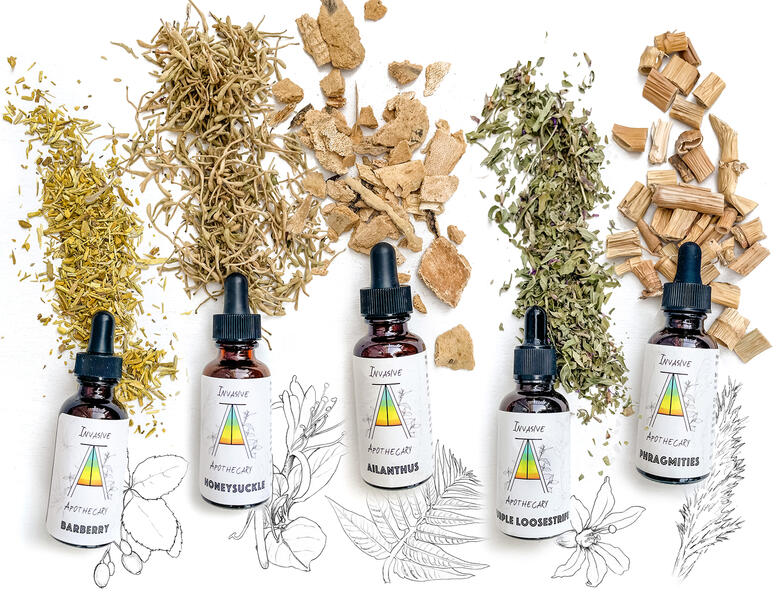 Invasive Apothecary: Heal the Land, Heal Your Body
Invasive Apothecary: Heal the Land, Heal Your BodyAs a clinical herbalist & artist I designed an Invasive Apothecary logo and created a line of herbal medicine tinctures (alcohol extraction of plant) of the top five most invasive plants in urban areas, specifically NYC (where I was living at the time). These "products" we made from safely sourced dried plant material from a Chinatown herb shop in Manhattan, NY.
While genetically modified agriculture is touted as the solution to world hunger, the very same GMO producers market toxic cancer-causing chemicals to spray on viable food & medicine that thrive within our very own neighborhoods. We have surrendered land management & ecosystem literacy to corporate driven “invasion gospel” at the cost of sovereignty & security over our own health & well-being.
Read more about the Invasive Apothecary here.
-
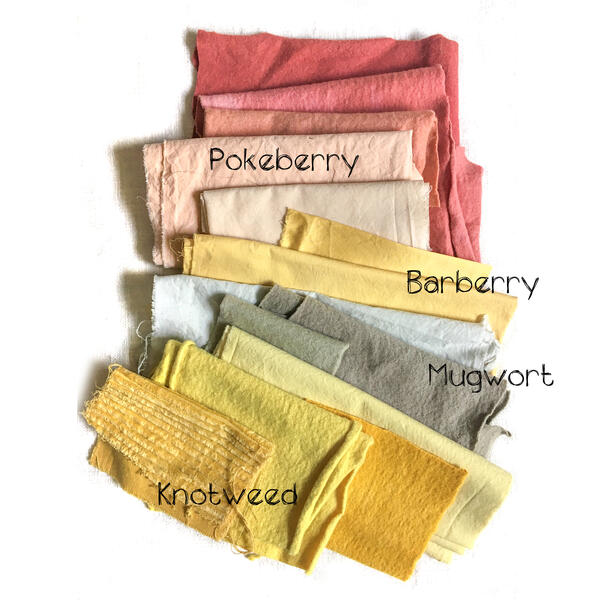 Invasive Plant Dye Samples
Invasive Plant Dye SamplesThroughout the seven years that I lived in Brooklyn, NY I got involved with many invasive plant removal events hosted by the parks department but also engaged in a daily ritual of walking the streets and forging through the parks on my own. These dye samples were made from plant material I collected of four different species of invasive plants. Because there are various un-knowns as to the safety of making medicine from material which was removed from potentially toxic urban sights, I thought using them as a dye would be a way to interact and learn from them in a much more safe way.
-
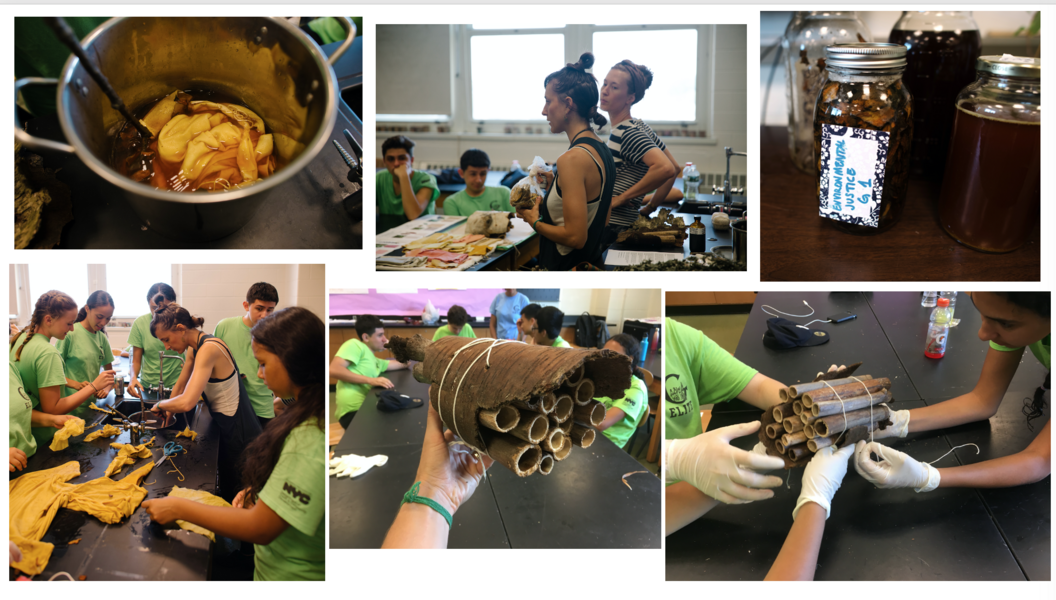 Invasive Plant Youth Workshop
Invasive Plant Youth WorkshopIn collaboration with the Greater Ridgewood Youth Council and NYCH2O teens removed Knotweed and other invasives from Highland Park, Queens, NY. As part of their programing I was invited to come talk to them about the social/environmental justice implications of demonizing immigrant invasive species while engaging them in a fabric dying workshop. We also made native bee houses from the hollow shoots of the Knotweed. Native North America Orchard Mason and leafcutter bees are solitary cavity nesters and do not use communal hives like the non-native honeybee. We can help these native pollinators thrive, filling a symbiotic niche by using the dried hollow shoots to houses are dear friends.
-
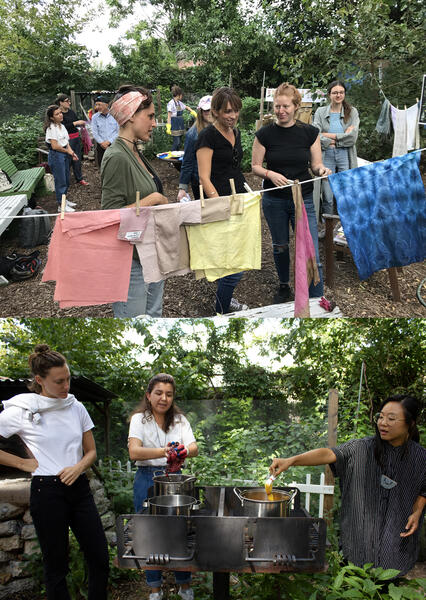 Invasive Medicinal Plant Dye Workshop
Invasive Medicinal Plant Dye WorkshopAs a part of this project I hosted an invasive medicinal plant dye workshop at Imani Garden in Brooklyn which was the community garden I was a member of at the time.
Pitch Bow
In 2016 I designed and built the Pitch Bow house in collaboration with interactive community based artist-run experimental art initiative New Orleans Airlift and musical tinkerer/engineer Ranjit Bhatnagar as part of a musical architecture project called the Music Box Village. The Pitch Bow was built using 80% reclaimed materials and includes musical floor boards & a door that functions like a slide guitar. Along with seven other pieces of musical architecture, the Pitch Bow is regularly performed & played, at its permanent home in New Orleans, by professional local & international musicians, artists & children alike. Visit New Orleans Airlift website or check out their Instagram for upcoming events and public days.
Pitch - refers to the pitch of the roof but also the varying levels of musical pitch that are made by the one string sliding guitar doors & the two nightingale noise floors.
Bow - refers to the diddly bow; a one stringer instrument from West Africa often considered a children’s toy consisting of a single string tensioned between two ends of a wooden bow laying across a hollowed out calabash fruit which magnifies the resonance of the sting when plucked. In the Deep South of the U.S. the diddly bow is widely excepted to have influenced the development of the blues sound which, in this version, consisted of baling wire tensioned between two nails on a board over a glass bottle, which is used both as a bridge and as a means (like the calabash fruit) to magnify the instrument's sound. Many consider the diddly bow a precursor to the slide guitar & even the Bango.
Nightingale Noise Floors - an additional inspiration for this musical house comes from the centuries-old technique used in Japan commonly found in palaces & temples as an ingenious way of keeping intruders from breaking in and stealing their prized treasures. Nightingale floors, or uguisubari, which literally means “bush warbler bird guard watch” in Japanese are designed to make a "chirping" sound when walked upon. Constructed from dried boards designed in a way that the flooring nails rub against a metal jacket or clamp, creating the sound.
-
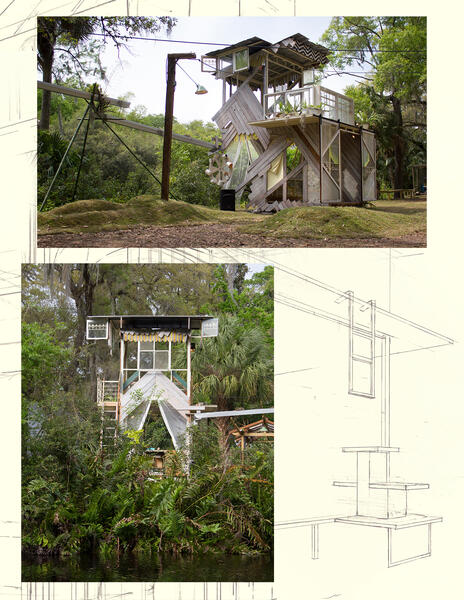 Pitch Bow
Pitch BowThis is the Pitch Bow music house completed.
-
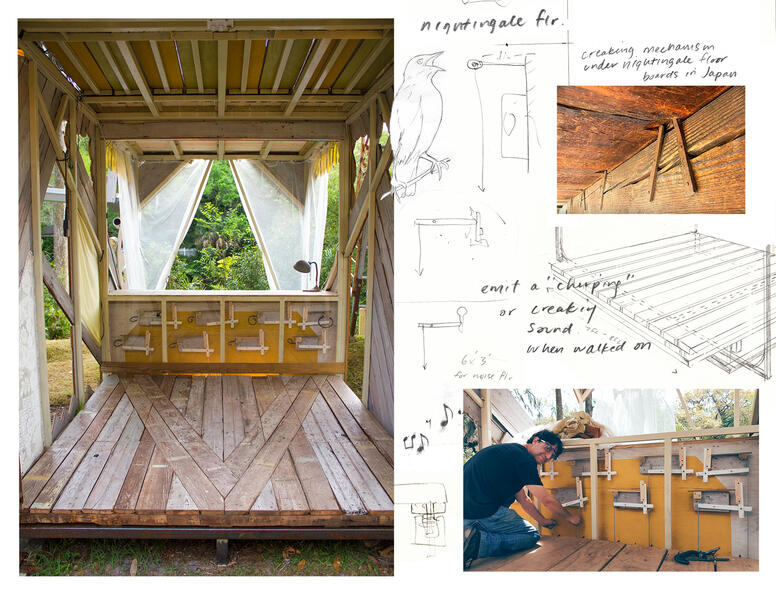 Pitch Bow (Detail)
Pitch Bow (Detail)This is a detail of the nightingale floor & the mechanisms which were designed & constructed to produce the sound when anyone walks on the floor boards.
-
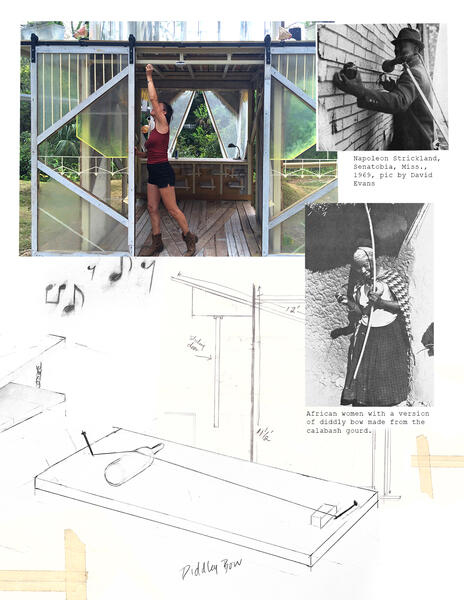 Pitch Bow (Detail)
Pitch Bow (Detail)This detail pic shows how the one string slide guitar door works & two pictures of the inspiration for the door, the Diddley Bow.
-
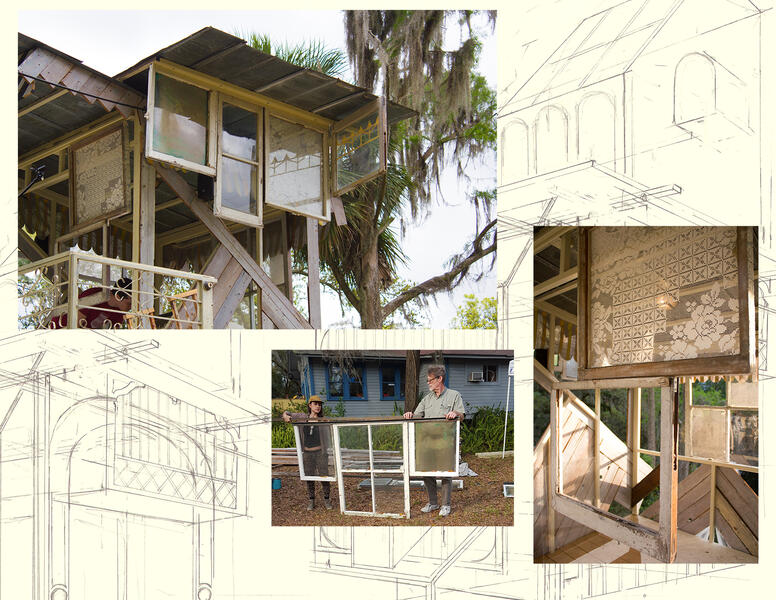 Pitch Bow (Detail)
Pitch Bow (Detail)An artistic detail of combining reclaimed windows together one of which also operates as a slide guitar window.
-
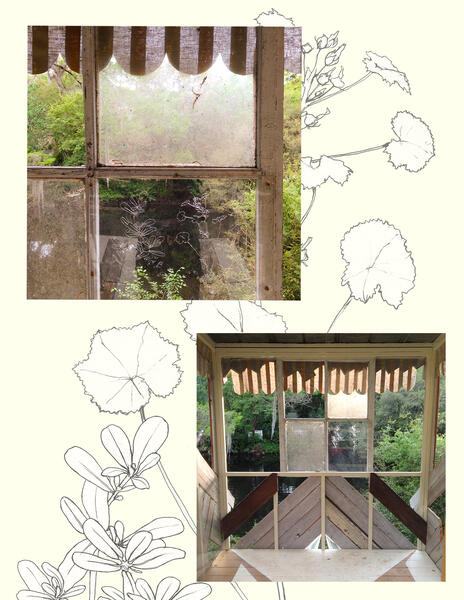 Pitch Bow (Detail)
Pitch Bow (Detail)Detail of the Pitch Bow musical house. I did drawings of plants growing at the site & etched them into the reclaimed Plexiglas windows.
-
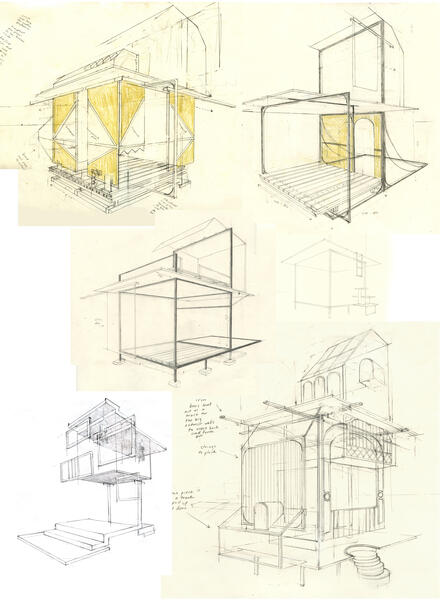 Pitch Bow Sketches
Pitch Bow SketchesThese are some of the drawings done as preliminary sketches done in order to prepare to build.
-
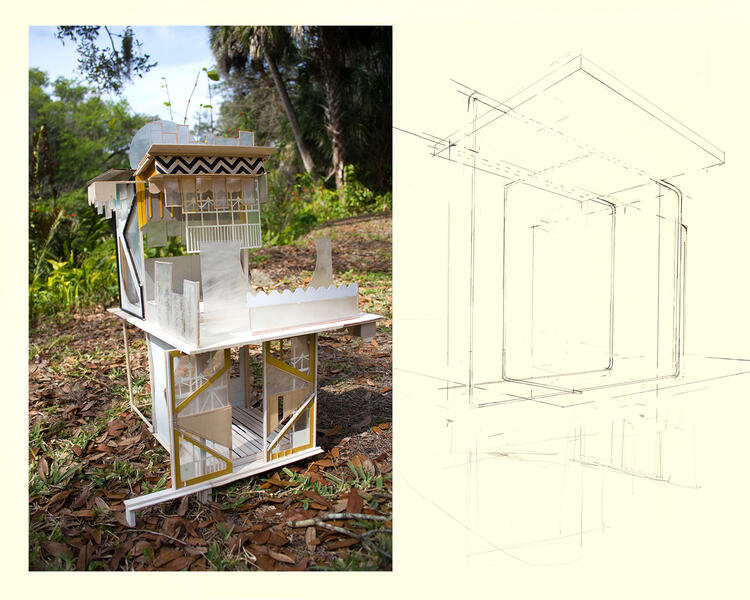 Pitch Box Architectural Model
Pitch Box Architectural ModelThis was the architectural model I created before construction began.
-
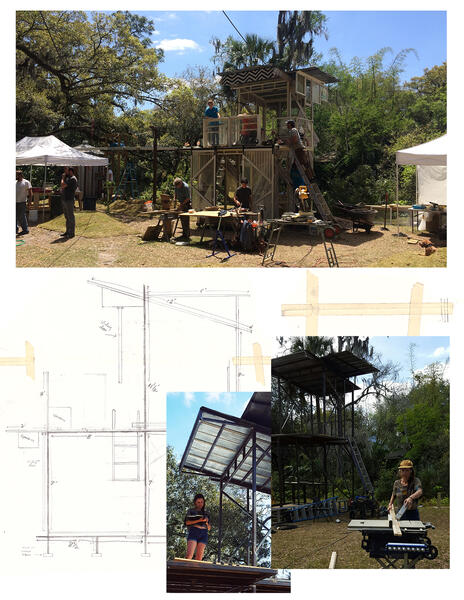 Pitch Bow Construction
Pitch Bow ConstructionThese picture show the pitch bow during construction.
-
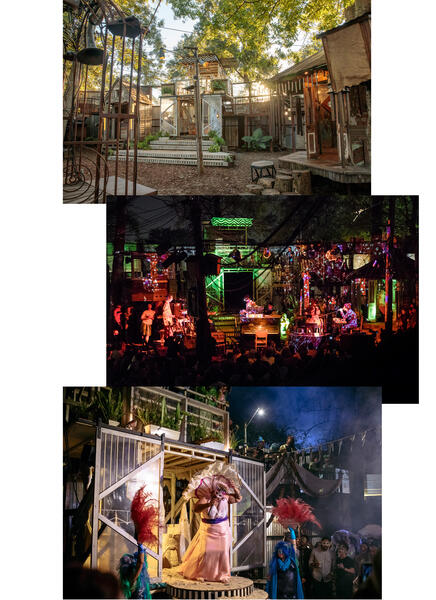 Music Box Performances
Music Box PerformancesAlong with seven other pieces of musical architecture, the Pitch Bow is regularly performed & played, at its permanent home in New Orleans, in the Music Box Village by professional local & international musicians, visitors, artists, children & other members of the community.
Raw Material
Raw Material is a project & exhibition which was created while I was an artist-in-residence at Parse Gallery, New Orleans in 2012. Raw Material refers to my explorations into (as well as my hands-on experience) of the environmentally sustainable non-industrial building methods/materials of strawbale (wheat) & adobe (clay) construction. It is about the historical deviations in the U.S. away from building dwellings of raw material such as sod, adobe & thatch but also highlights the overlooked contemporary work of Michael Reynolds Earthship architecture & the work of Dan Phillips who focused on building low-income housing out of recycled material. Throughout the installation I have utilized cut-outs of people photographed by Solomon Butcher who were some of the first colonial settlers to begin expanding across the U.S. after the Homestead Act of 1862. Touted as an epoch of American history these photographs speak strongly of a time when people were building their own houses (from sod, adobe & thatch) but was also the very beginnings of the ideas of property and the demarcation and commodification of land in this country.
Estimates state that current construction & demolition activities from modern conventional forms of building account for approximately 40% of the solid waste generated yearly & accounts for 100 million tons of waste in the United States alone. With these estimates it makes the construction industry one of the most wasteful industries in the world yet is rarely discussed.
-
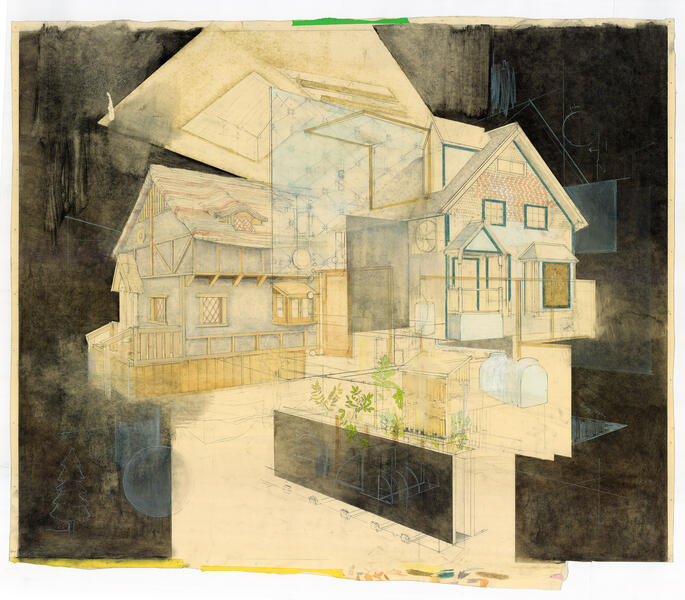 Amalgamation
AmalgamationAmalgamation, graphite, pastel, gouache on manilla pattern making paper, 30’’x36’’, 2014
This piece was done in response to the incredible work of eco builder/architect Dan Phillips who built one-of-a-kind low-income housing out of 90% recycled materials under his business entity Phoenix Commotion.
-
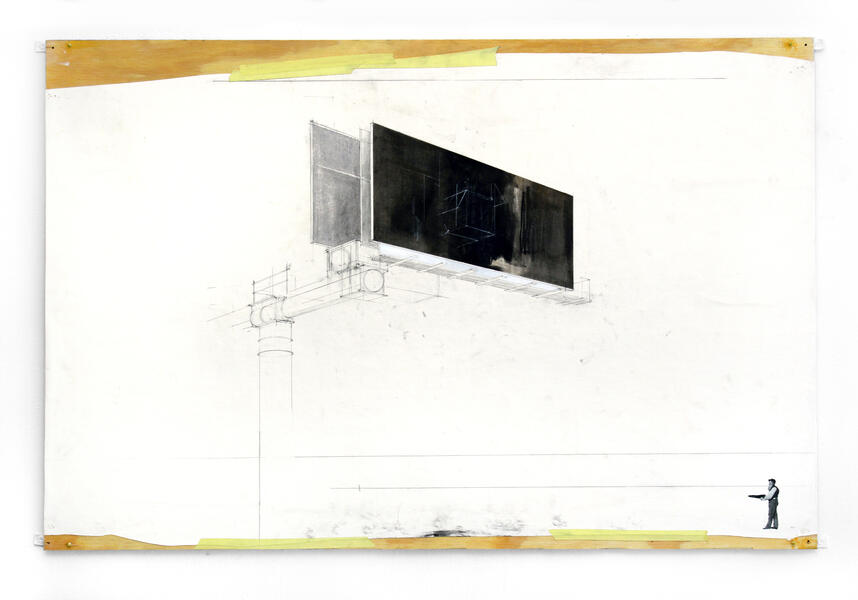 Raw Material (install detail)
Raw Material (install detail)Raw Material installation detail
Billboards fashioned as chalkboards advertise a new form of learning as these living systems restructure themselves toward a new beginning.
-
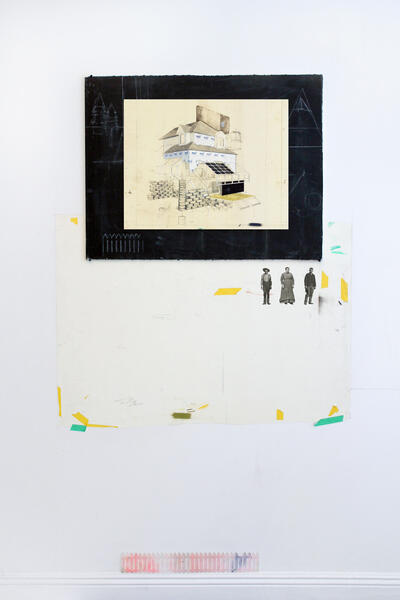 Raw Material (install detail)
Raw Material (install detail)Raw Material installation detail which includes a drawing called Retrofit which depicts a McMansion retro-fiting itself into an Earthship.
-
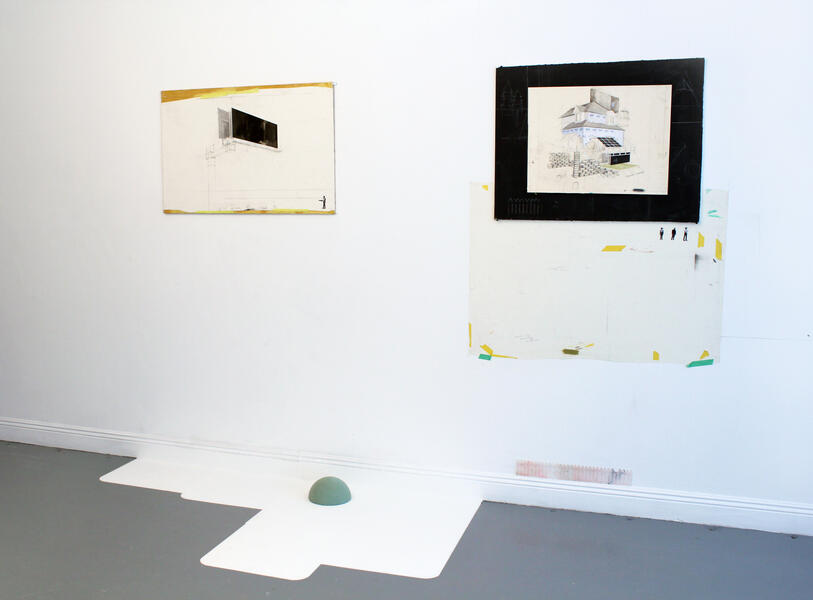 Raw Material (install detail)
Raw Material (install detail)Raw Material installation details include a drawing called Retrofit and Chalkboard Billboard 1.
-
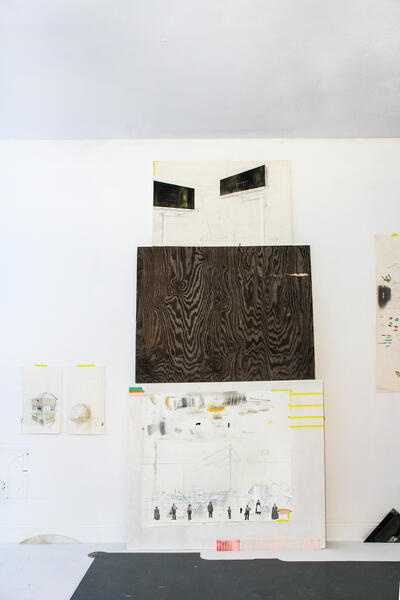 Raw Material
Raw MaterialRaw Material is a project & exhibition created while I was an artist-in-residence at Parse Gallery, New Orleans in 2012. The title Raw Material refers to my explorations into as well as my hands-on experience with environmentally sustainable non-industrial building methods & materials such as strawbale (wheat) & adobe (clay). Estimates state that current construction & demolition activities from modern conventional forms of building account for approximately 40% of the solid waste generated yearly & accounts for 100 million tons of waste in the United States alone. With these estimates it makes the construction industry one of the most wasteful industries in the world yet is rarely discussed. I wanted to create a conversation around some of the historical deviations in the U.S. from building dwellings from raw material such as sod, adobe & thatch but also highlight the overlooked contemporary work of Michael Reynolds Earthship architecture & Dan Phillips which focused on building low-income housing out of recycled material. Positioned in contrast to the above I have utilized cut-outs, throughout the installation, of people photographed by Solomon Butcher of some of the first colonial settlers to begin expanding across the U.S. landscape in the mid to late 19th century after the Homestead Act of 1862. These photographs are touted as an epoch of American history & speak strongly of a time when people in the U.S. were building their own houses from sod, adobe & thatch but it was also the very beginnings of the ideas of property and demarcation and commodification of land in this country.
-
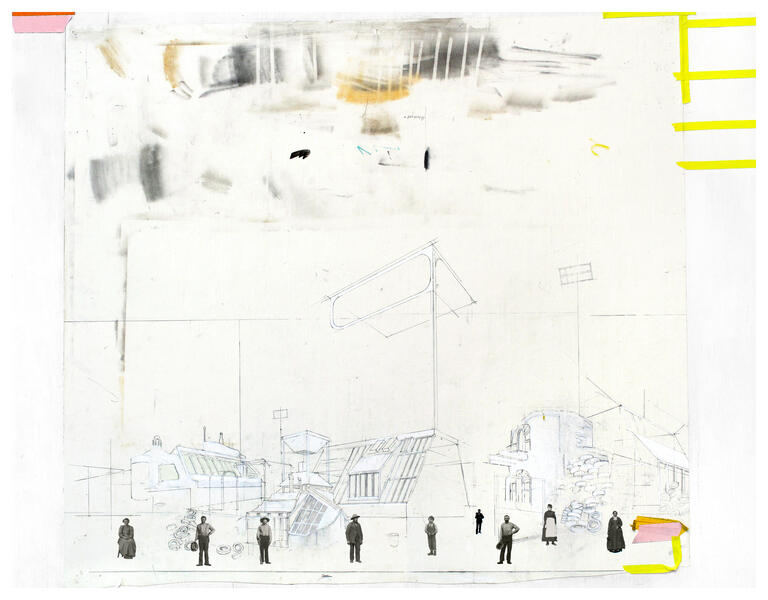 Raw Material (installation detail)
Raw Material (installation detail)Raw Material (installation detail)
-
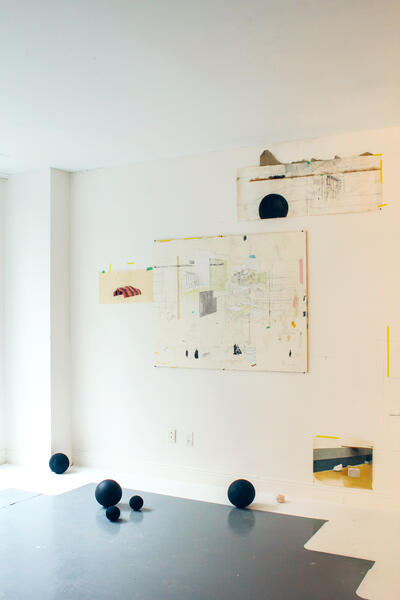 Raw Material (detail)
Raw Material (detail)Raw Material (detail)
-
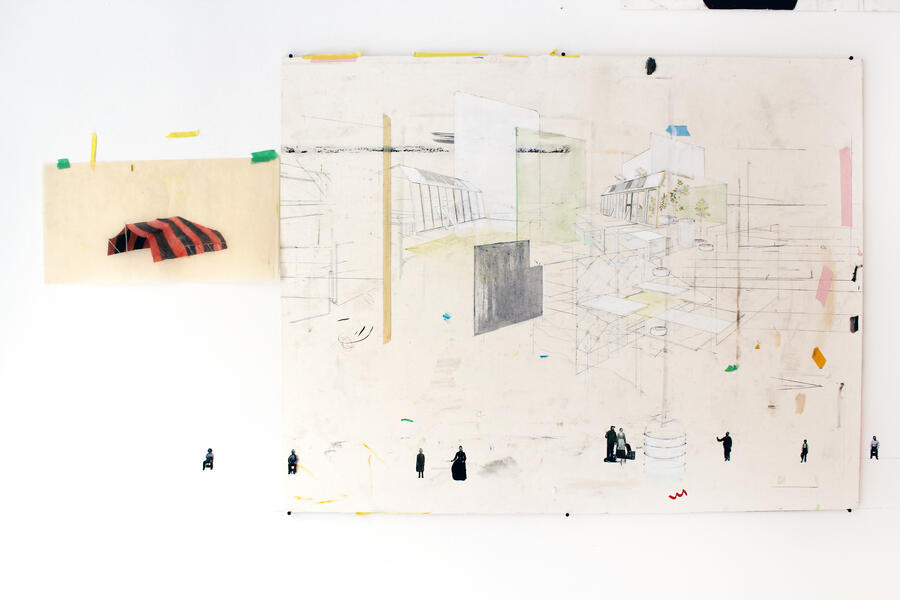 Raw Material (detail)
Raw Material (detail)Raw Material (installation detail) - details include the depiction of Earthship Architecture, a goat skin tent alongside cut-outs of individual people from the Solomon Butcher portraits.
-
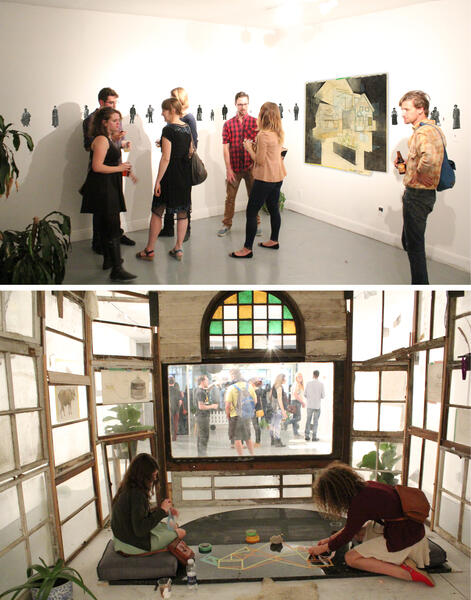 Raw Material (install detail)
Raw Material (install detail)A detailed shot of two more aspects of the Raw Material show. The top one depicts a drawing I did inspired by the contemporary work of Dan Phillips building low-income housing from recycled material alongside cut-outs of individual people from the Solomon Butcher portraits.
The bottom picture: I was lucky enough to collaborate with Roberto, one of the directors of Parse Gallery at the time to build a temporary structure inside the gallery made completely of reclaimed windows from the site which echoed an exploded 3D version of the architectural structures depicted in my drawings and served as a space for people who visit the exhibition a spot for creative play. I also hung drawings of non-electric food & water processing equipment and animals similar to what is depicted in my 2D work.
Eclipta Herbal
Eclipta Herbal is a venture I started in 2016 that combines my work as an artist together with my social practice of being a clinical herbalist and plant medicine educator. This endeavor has become a way of reviving the peoples medicine, curing the pandemic dis-ease of plant blindness and restoring the importance of place-based identity with the goal to build mutualistic relationships with our surrounding herbal allies. This work is at the intersection of health & wellness, resource sustainability, ecological literacy & sacred economics which recognizes non-hierarchical re-engagement with nature is the solution to reversing social/political & environmental upheaval. Eclipta propagates these intentions through one-on-one herbal medicine consultations, collaboration, guided plant tours, equitable in-person community workshops & visually dynamic activity-based educational games and other tools. Ultimately, the project seeks to contribute to our physical, mental & spiritual health by creating avenues of care so that we may continue a thriving symbiotic relationship with our fellow green sentient beings.
Listed under this project are educational items that I have designed in order to engage city dwellers with the abundance of unintentional "weedy" medicinal plants that grow all around us.
A way to creatively inspire learning about the ecology of the urban environment.
-
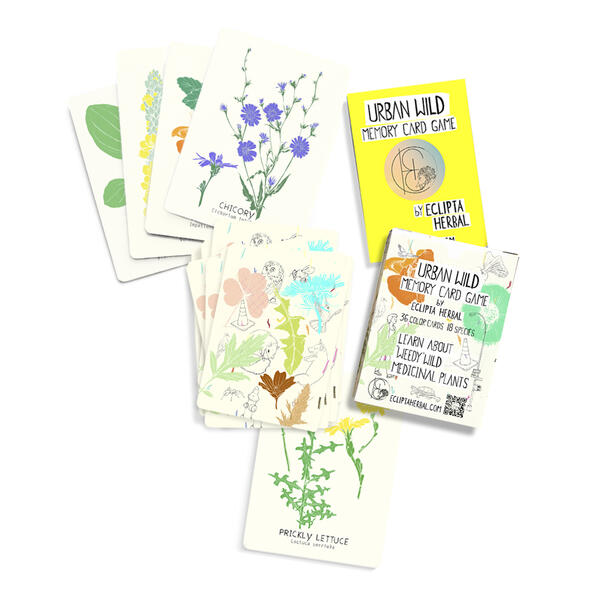 Urban Wild Weedy Medicine Memory Card Game
Urban Wild Weedy Medicine Memory Card GameThe Urban Wild "Weedy" Memory Card Game remembers or re-assembles our age-old cultural/historical human relationships with common medicinal plants which thrive in abundance within urban landscapes around the world & beyond. After 15yrs of conscientiously apprenticing with these unintentional “weedy” herbs & exploring who were my most common neighboring allies I made dozens of drawings of each species. There are 36 cards total which highlight 18 different species. The game includes an instruction booklet with more information about each plant & a link to 5 additional games you can play with the same deck.
Like most memory card games the object is to practice visual identification. While each species has 2 cards, each pair includes 2 different drawings of the same species. This provides an additional challenge to the game & recognizes that when learning to identify plants you will have to consider various stages of a species life cycle, each with subtle & sometimes not so subtle differences. This version focuses on learning leaf structure which is helpful as many plants can seem ubiquitously similar. 1. Notice there are many different shades of green on the spectrum. 2. Take note of flower color & shape, whether a plant has alternate or opposite leaves & if they have spiky, smooth or rounded edges. Click here to see a complete list of herbs, where & how to find them, safety, medicinal uses, other games you can play with this deck & more!
Creatively inspiring a re-connection with the ecology of the urban environment & beyond.
What's included?
36 cards total
36 different drawings
18 different species
Instruction booklet with more information
Why this game?
Without any previous practice or instruction plant ID can be discouragingly difficult. If you're like me I started out with the aid of plant ID guide books which is supportive BUT, from my experience, it is only when you have moderate to advanced training in plant ID from someone who really knows their stuff. With only 1 or 2 images, I have witnessed some of the short comings of traditional guide books & wondered if an engaging memory card game would aid in the process. Sensory repetition (visual or otherwise), in for example a game, is indeed key to securing accurate identity of plants that can look frustratingly similar. It's all about discovering the finer details.
-
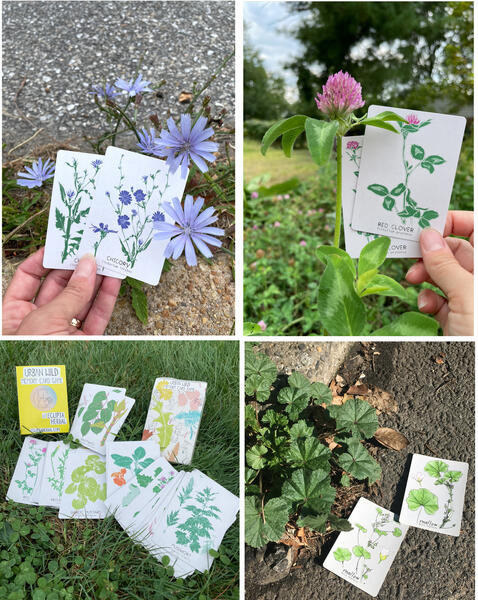 Urban Wild Weedy Medicine Memory Card Game (details)
Urban Wild Weedy Medicine Memory Card Game (details)Urban Wild Weedy Medicine Memory Card Game detail pictures. Most of these hardy species thrive by pushing though cracks in the concrete. A forgotten voice from the ancient yet disturbed & disgraced soil beneath.
-
 Urban Wild Weedy Medicinal Activity Book
Urban Wild Weedy Medicinal Activity BookUrban Wild Weedy Medicinal coloring and activity book contains 100's of botanical drawings done over a 5 year period as an urban ecological study. The book engages city dwellers in becoming familiar with the diversity of wild "weedy" medicinal plants which grow unintentionally right outside our door. Flourishing abundantly in every city in the Northeastern United States these herbal allies are hardy, resilient & have a lot to tell us about the landscape in which we inhabit. The human uses of these plants can be traced through time, giving us a window into the historical & cultural contexts of our surroundings. This book is meant to be used as an opportunity to get to know a small piece of the urban ecological landscape, but also question the low esthetic value we place on these particular plant species. As we become more aware of our herbal allies we are empowered to become our own community connectors & healers.
This book provides a creative way to inspire learning about the ecology of the urban environment. A platform for observing & connecting to natural rhythms & cycles while recognizing that our bodies & that of the Earth body are one-in-the-same. Become part of a larger movement to renew & strengthen your relationship with your interconnected community of humans, plants, animals & insects. In an age of separation & environmental crisis, connecting with nature is vital to our survival.
Includes:
64 dynamic pages to color
an I Spy game
a full color glossary of each plant pictured on the inside cover
also includes common animals & insects found within urban areas
room to draw the plants you've found in your neighborhood and more!
-
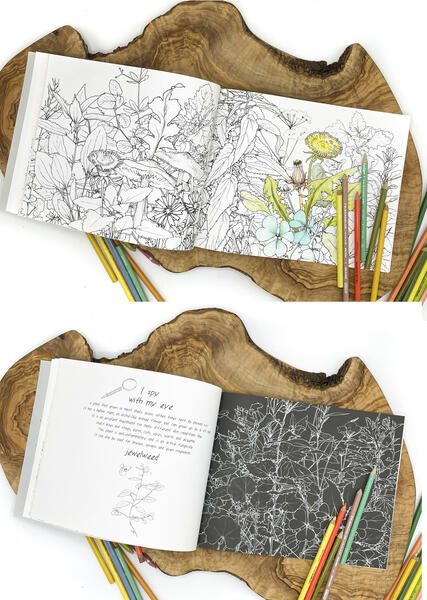 Urban Wild Weedy Medicinal Activity Book (details)
Urban Wild Weedy Medicinal Activity Book (details)Two details of the inside of the Urban Wild Weedy Medicinal Activity book.
-
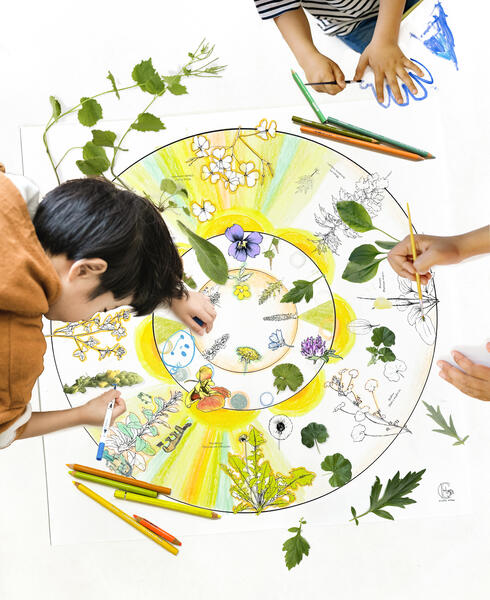 Urban Herbal Sacred Circle
Urban Herbal Sacred CircleThis collaborative coloring activity recognizes that we are in relationship with these incredible herbal medicine plant allies & are all part of a sacred whole. It is an excellent interactive activity for all ages or as an environmental education tool for various workshops & classes. It comes as a 24’’x24’’ black & white print on 24lb paper. Species included: Mallow (Malva neglecta) Red Clover (Trifolium pratense) Wood Sorrel (Oxalis acetosella) Plantain (Plantago major) Garlic Mustard (Alliaria petiolata) Mullein (Verbascum thapsus) Mugwort (Artemisia vulgaris) Dandelion (Taraxacum officinale)
-
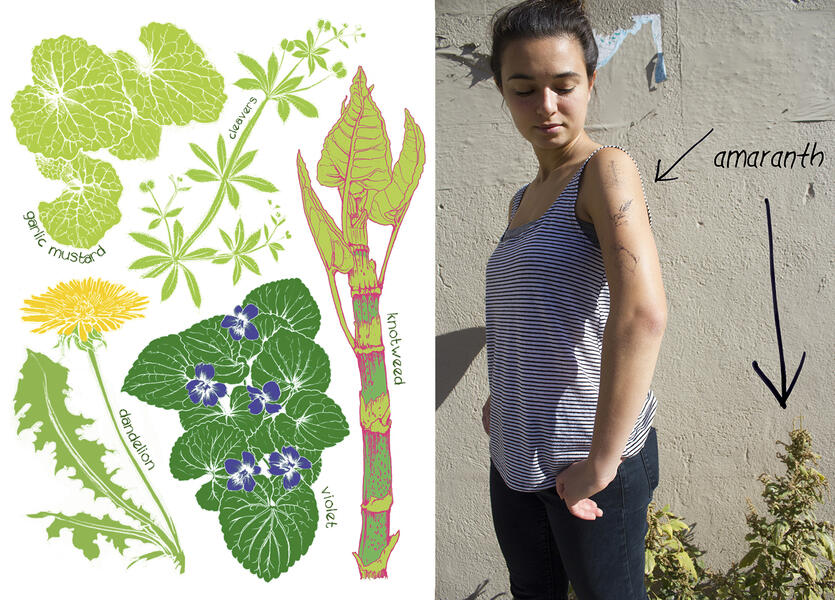 Urban Wild Weedy Temporary Tattoos
Urban Wild Weedy Temporary TattoosThese Urban Wild Weedy Temporary Tattoos were designed so that you can wear your plant ID guide book on your body when you go foraging or on an urban plant walk through the city. In addition, seeing them on your skin a few days in a row helps to remember their physiognomy better in order to build confidence towards more accurate identification.
Historically, tattooing was/is a form of memory aid. These temporary tattoos act as form of remembering our relationship with these species.
I encourage those who wear them to imagine how people might live or have lived without a written language. How might we pass down or remember certain information about our environment? Without the ability to record language in words lots of information was or can be stored within one image. Much like a pictograph or mnemonic tool.
-
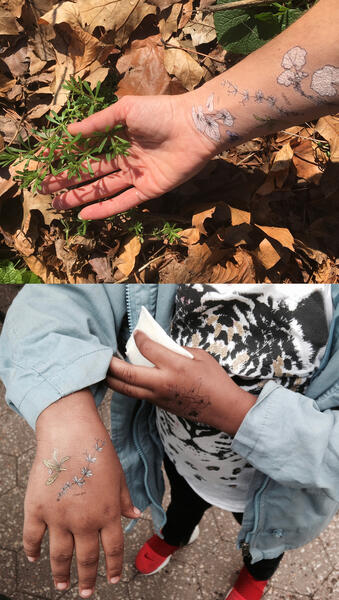 Urban Wild Weedy Temporary Tattoos (detail)
Urban Wild Weedy Temporary Tattoos (detail)These Urban Wild Weedy Temporary Tattoos were designed so that you can wear your plant ID guide book on your body when you go foraging or on an urban plant walk through the city. In addition, seeing them on your skin a few days in a row helps to remember their physiognomy better in order to build confidence towards more accurate identification.
Historically, tattooing was/is a form of memory aid. These temporary tattoos act as form of remembering our relationship with these species.
I encourage those who wear them to imagine how people might live or have lived without a written language. How might we pass down or remember certain information about our environment? Without the ability to record language in words lots of information was or can be stored within one image. Much like a pictograph or mnemonic tool.
-
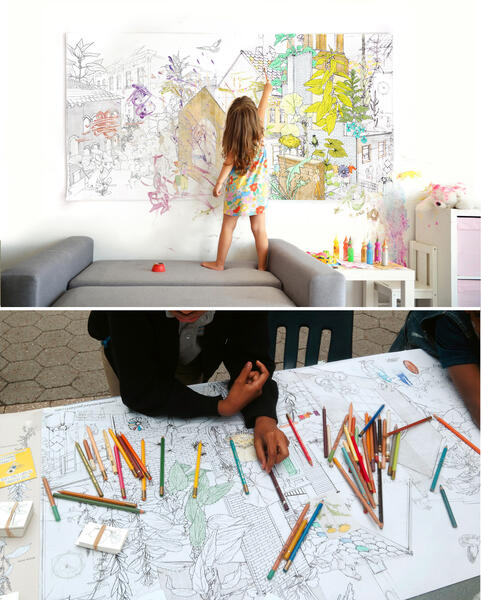 Urban Wild Weedy Jumbo Collaborative Coloring
Urban Wild Weedy Jumbo Collaborative ColoringI created a collaborative jumbo coloring poster version of one of the pages out of the Urban Wild Weedy coloring and activity book. This page not only includes wild weedy medicinal plant species but also includes common animals & insects found within urban areas as well. A way to creatively inspire learning about the ecology of the urban environment.
-
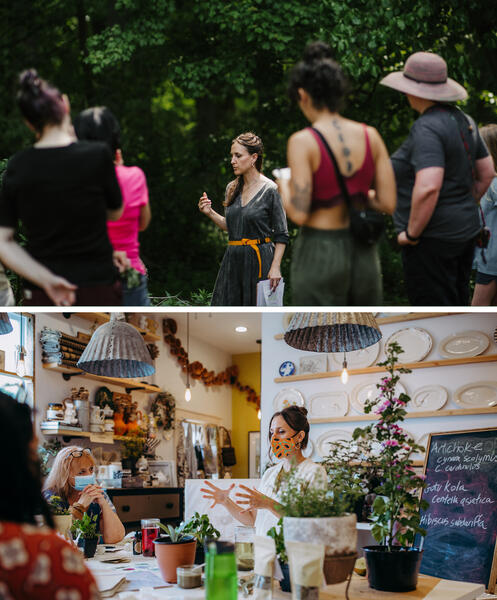 Alyssa Teaching About Herbs
Alyssa Teaching About HerbsAlyssa teaching class participants about the healing gifts of herbal medicine both outside at Irvine Nature Center and inside with various potted herbs and herbal preparations at Walther Gardens.
-
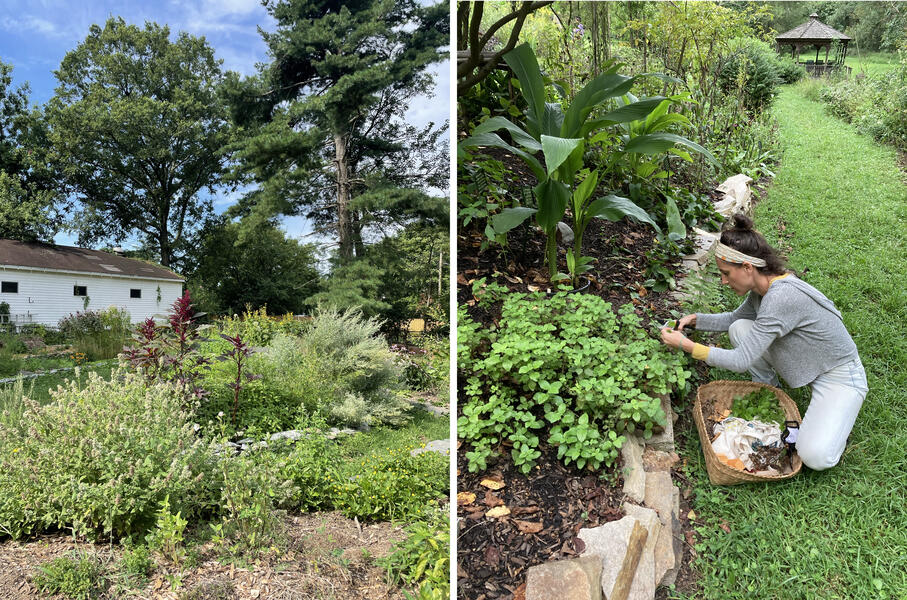 Eclipta Herbal Sanctuary
Eclipta Herbal SanctuaryIn addition to teaching herbal medicine workshops within the community and making interactive educational games this social/environmental practice also includes the cultivation of a 0.7 acre herbal medicine sanctuary located within Baltimore City. The main function of my cultivation efforts is for educational community engagement. I am now in my 4th growing season.
Urban Edible Aid
Urban Edible Aid was an installation project I completed as an artist-in-resident at Lobot Gallery in the industrial warehouse complex of West Oakland, CA. Not being from Oakland I spent 2-3 weeks taking countless walks & bike rides around the city with various plant guides to get to know the land.The piece showcases 19 of 33 known edible and medicinal plants found in Oakland all of which were foraged from no more than a 3 block radius of the gallery. Each of the glass vials is supported by one or more colored rubber bands which correspond to the color coded anatomical drawings of internal organs. Pink, for example, demonstrates that any plant with a pink rubber band is good for digestive complaints while yellow can be used for skin irritations, blue for respiratory, etc. Many species can be used for more than one ailment. Species include:
Cutleaf geranium Geranium dissectum
Dandelion
Lesser-seeded bittercress
Sweet Alyssum (Lobularia maritima)
Arum italicum (Lords and Ladies)
Annual bluegrass Poa annua (Family Poaceae
California burclover Medicago polymorpha (Family Fabaceae)
Common groundsel Senecio vulgaris (Family Asteraceae)
Rumex hymenosepalus, Rumex acetosella and Rumux crispus, can also be known as wild rhubarb, Sheep Sorrel, Sour cane, Tanner’s dock, Sour dock, Pie dock, Curly leaf, Dock, and Yellow Dock.
-
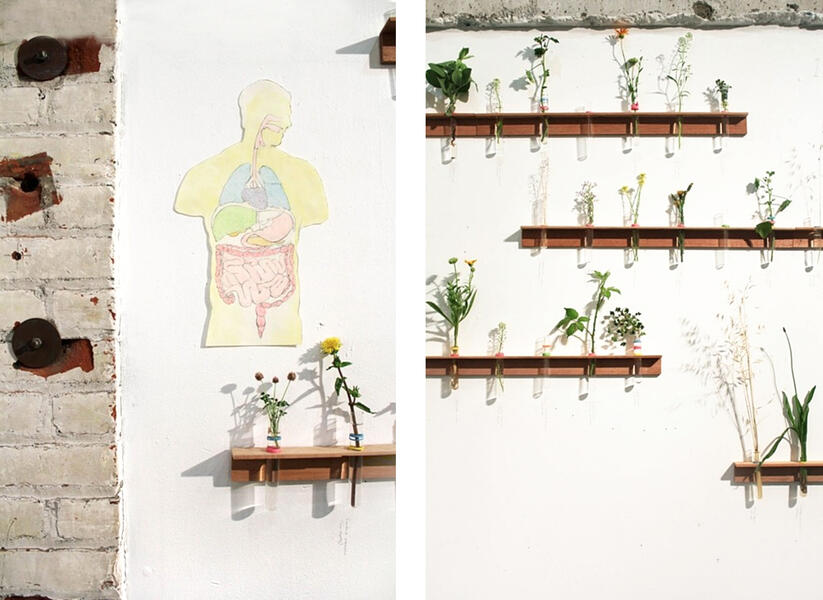 Urban Edible Aid
Urban Edible AidUrban Edible Aid was an installation project I completed as an artist-in-resident at Lobot Gallery in the industrial warehouse complex of West Oakland, CA. Not being from Oakland I spent 2-3 weeks taking countless walks & bike rides around the city with various plant guides to get to know the land.The piece showcases 19 of 33 known edible and medicinal plants found in Oakland all of which were foraged from no more than a 3 block radius of the gallery. Each of the glass vials is supported by one or more colored rubber bands which correspond to the color coded anatomical drawings of internal organs. Pink, for example, demonstrates that any plant with a pink rubber band is good for digestive complaints while yellow can be used for skin irritations, blue for respiratory, etc. Many species can be used for more than one ailment. Species include:
Cutleaf geranium Geranium dissectum
Dandelion
Lesser-seeded bittercress
Sweet Alyssum (Lobularia maritima)
Arum italicum (Lords and Ladies)
Annual bluegrass Poa annua (Family Poaceae
California burclover Medicago polymorpha (Family Fabaceae)
Common groundsel Senecio vulgaris (Family Asteraceae)
Rumex hymenosepalus, Rumex acetosella and Rumux crispus, can also be known as wild rhubarb, Sheep Sorrel, Sour cane, Tanner’s dock, Sour dock, Pie dock, Curly leaf, Dock, and Yellow Dock.
-
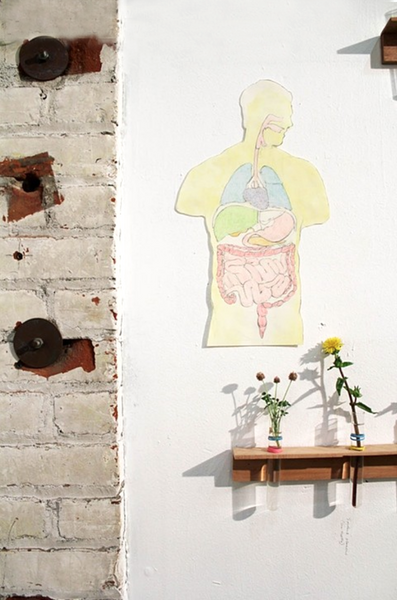 Urban Edible Aid (detail)
Urban Edible Aid (detail)Urban Edible Aid (detail)
-
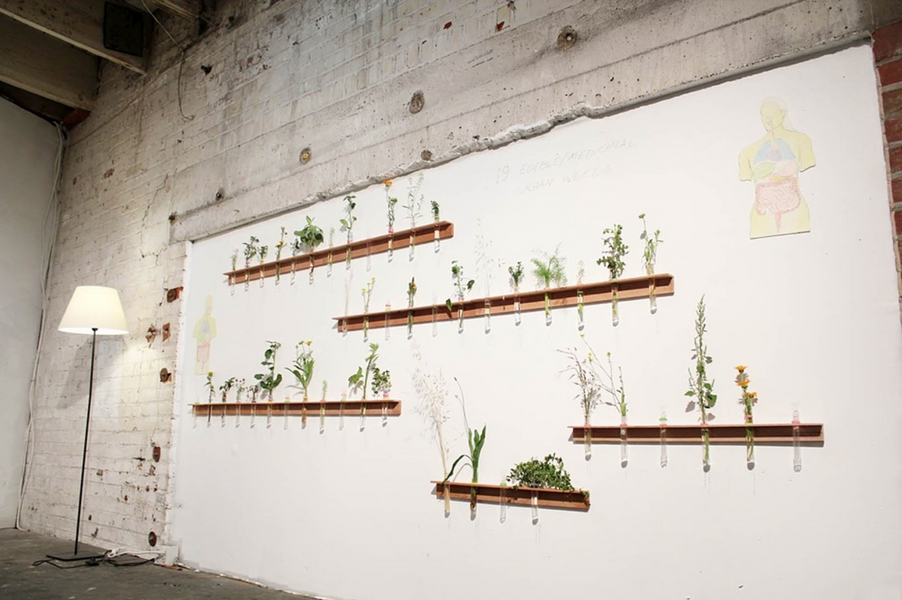 Urban Edible Aid (detail)
Urban Edible Aid (detail)Urban Edible Aid (detail)
-
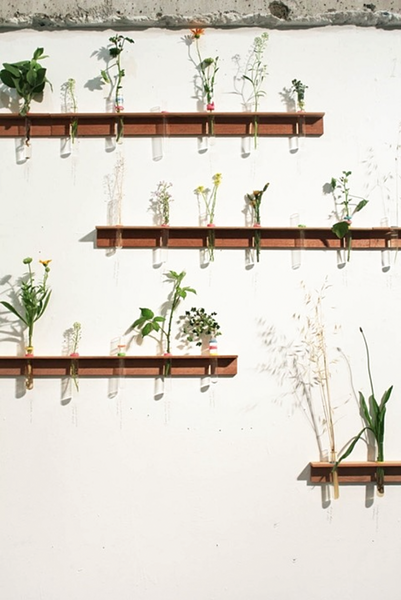 UrbanEdibleAid-herbs4.png
UrbanEdibleAid-herbs4.pngUrban Edible Aid (detail)
-
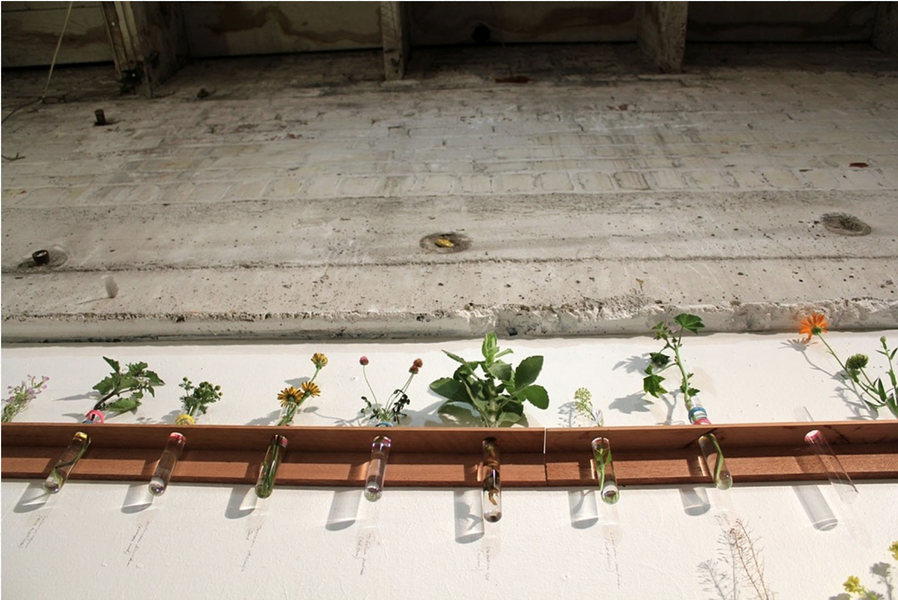 Urban Edible Aid (detail)
Urban Edible Aid (detail)Urban Edible Aid (detail)
Works on Paper 2
continued from Works on Paper 1
Like a seed, one or two marks on paper slowly germinate out in all directions, an unfolding process, leaving the demarcations between inside and outside space ambiguous. My drawings are produced with a scientific meticulousness, that can at any moment, be intuitively erased, scraped or layered into forms of suspension and modularity. Like schematics of an archeological excavation, these tectonic forms hang in transparent layers of memory of pre- and post-industrial time. Amid the dusty, pastel hues of dawn or dusk, these dream-like settings of place and non-place wax and wane within a process state between construction, creation or assembly, and decomposition, demolition or decay. Much like a set of child’s building blocks, they are always vulnerable to rearrangement. The presence of the occasional plant or animal serves as a reminder that human made structures have displaced these species yet their ghosts graze on another “plane” just beneath our feet. In addition, the placement of certain mundane elements takes on a mythic presence alluding to a time when dwellings were tools for connecting to and understanding elemental and celestial phenomenon. Images of modern material culture, such as used tires or reclaimed Plexiglas, point to the failures of capitalism, modern ideas of “progress” and dead-end systems of waste. Billboards fashioned as chalkboards advertise a new form of learning as these living systems restructure themselves toward a new beginning.
-
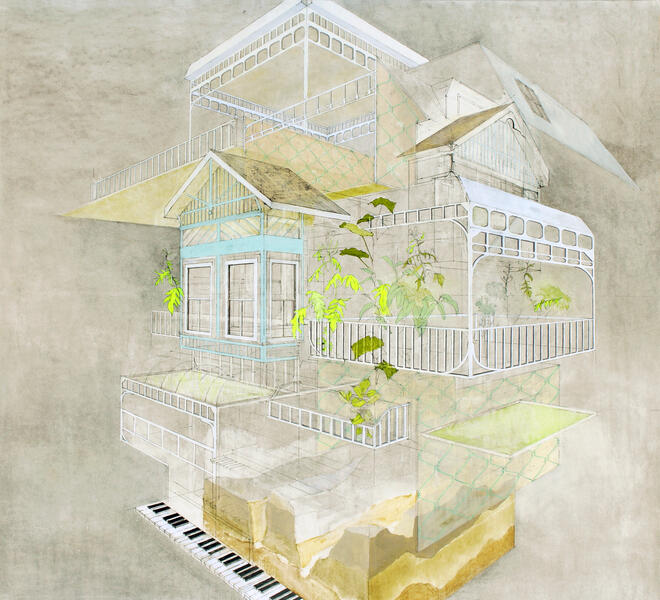 Conservatory
ConservatoryConservatory, graphite, pastel, gouache, colored pencil on paper mounted to board, 36’’x42’’, 2012
-
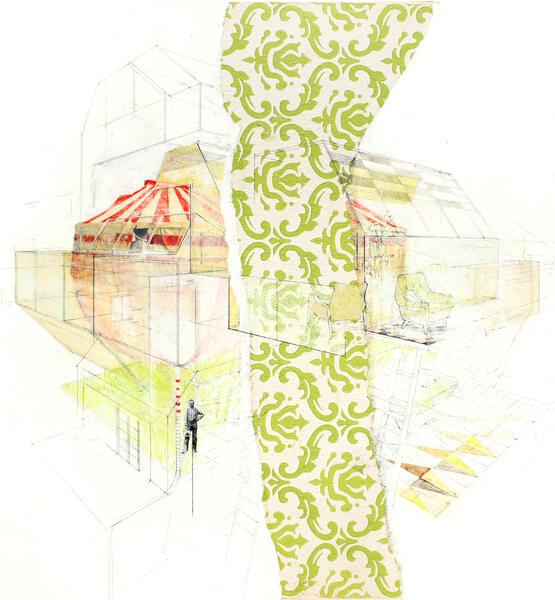 Circus Tent
Circus TentCircus Tent, graphite, ground pigment, colored pencil, 20’'x22'', 2012
-
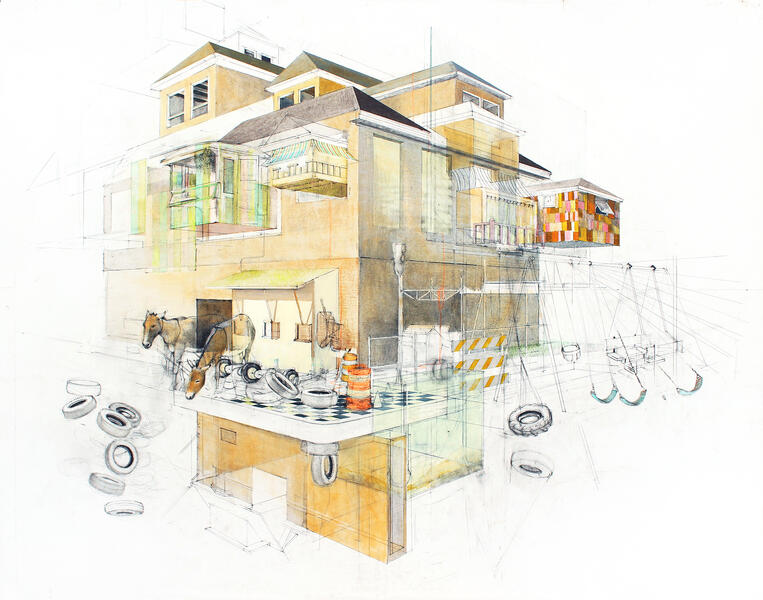 Extensions
ExtensionsExtensions, graphite, ground pigment, colored pencil, 42’'x54'', 2011
-
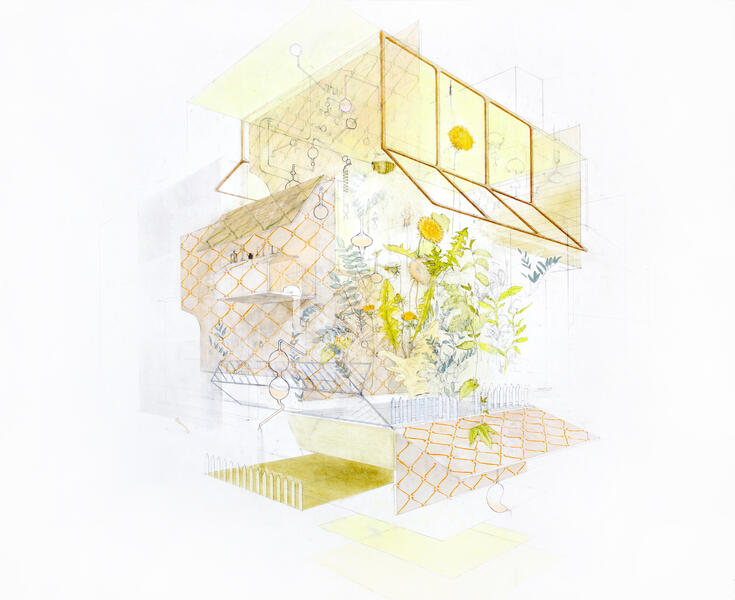 Schematic Digestion
Schematic DigestionSchematic Digestion (meadowsweet, dandelion, licorice, calendula, peppermint), graphite, gouache, colored pencil, pastel, 52’’ x 42’’, 2012
-
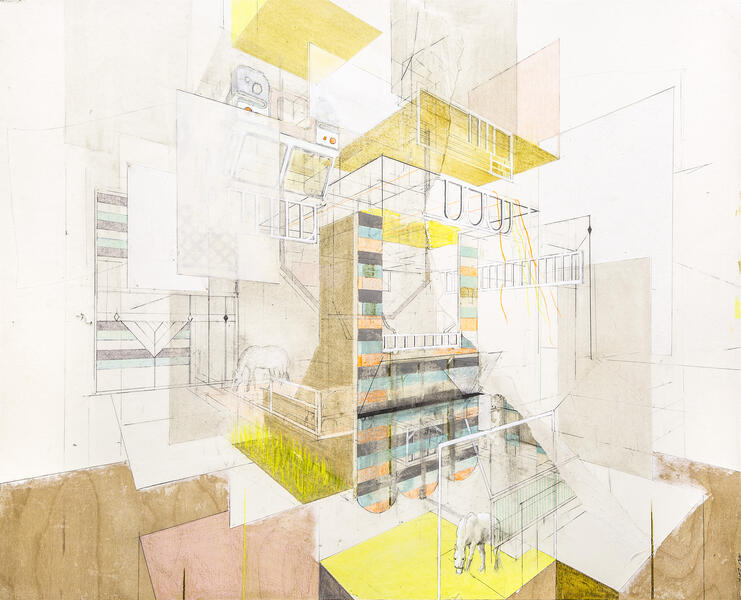 Contruct
ContructConstruct, graphite, colored pencil, pastel, gouache on paper mounted to board, 24’’x32’’, 2017
-
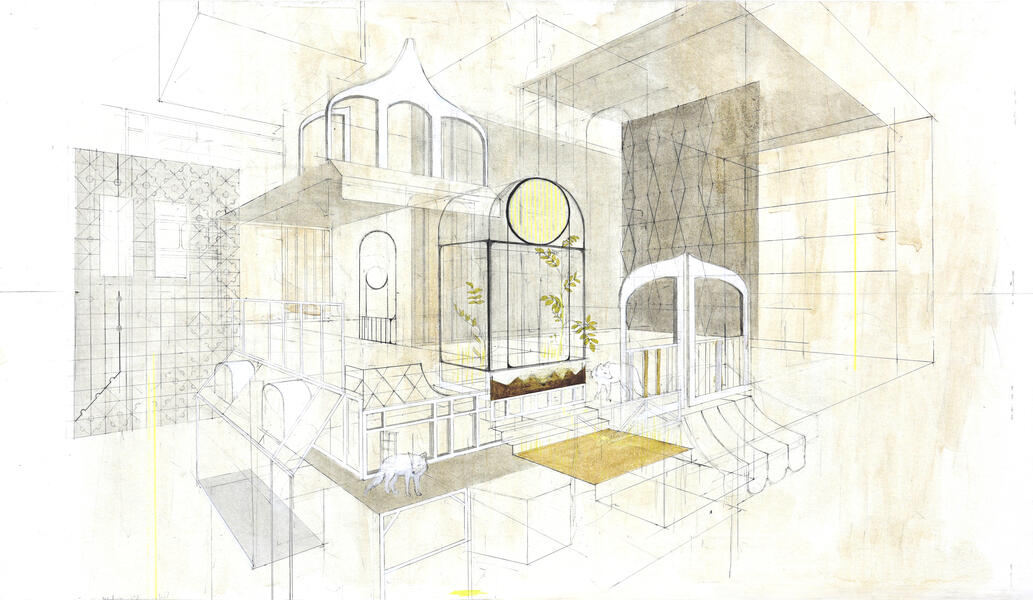 Winter Greenhouse
Winter GreenhouseWinter Greenhouse, graphite, pastel, colored pencil, gouache on paper, 18.5’’x32’’, 2015
-
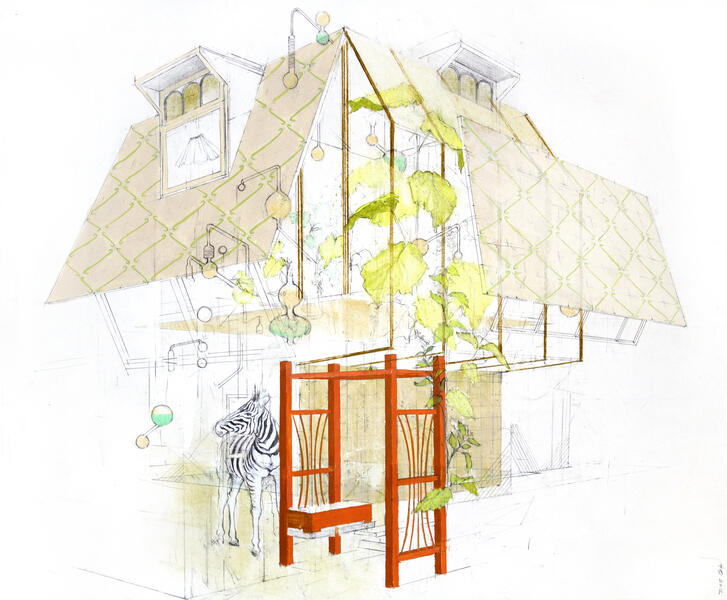 Acclimation
AcclimationAcclimation, graphite, colored pencil, gouache, pastel on paper, 18''x24'', 2012
-
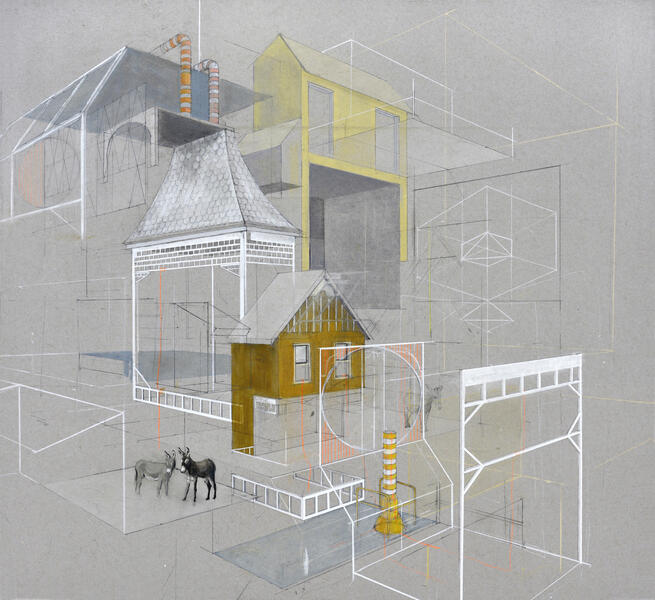 Sub Level
Sub LevelSub Level, graphite, pastel, colored pencil, gouache on paper, 20''x 27'', 2015
-
Integration Attempt
Integration Attempt, graphite, colored pencil, gouache, ground pigment, collage, 38’'x75", 2009
-
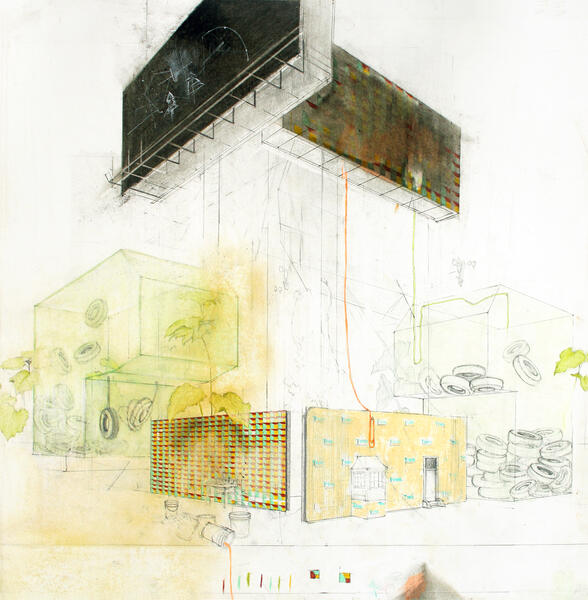 Home School
Home SchoolHome School, graphite, ground pigment, colored pencil on paper mounted on board, 19.5’’x20’’, 2011











